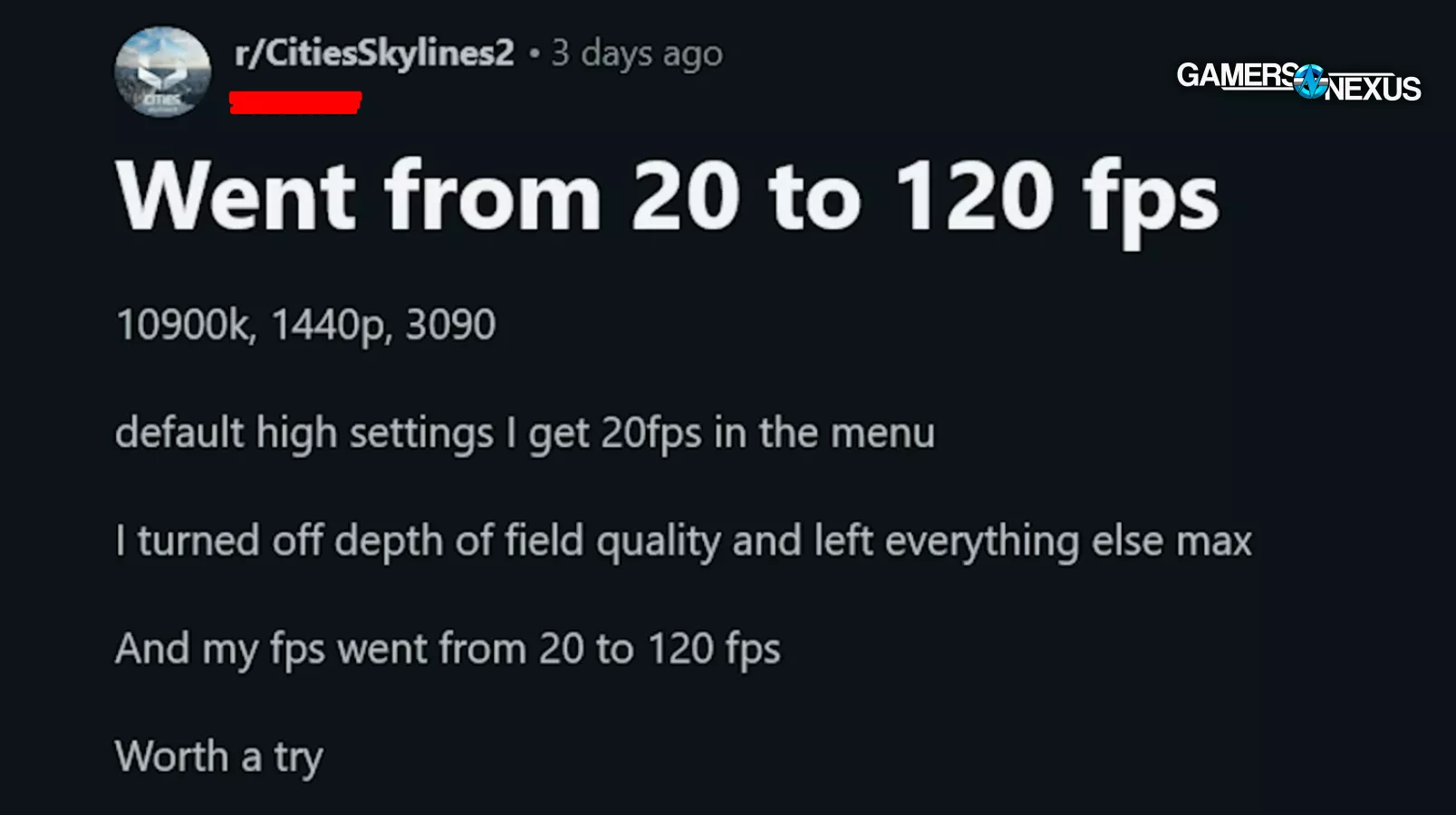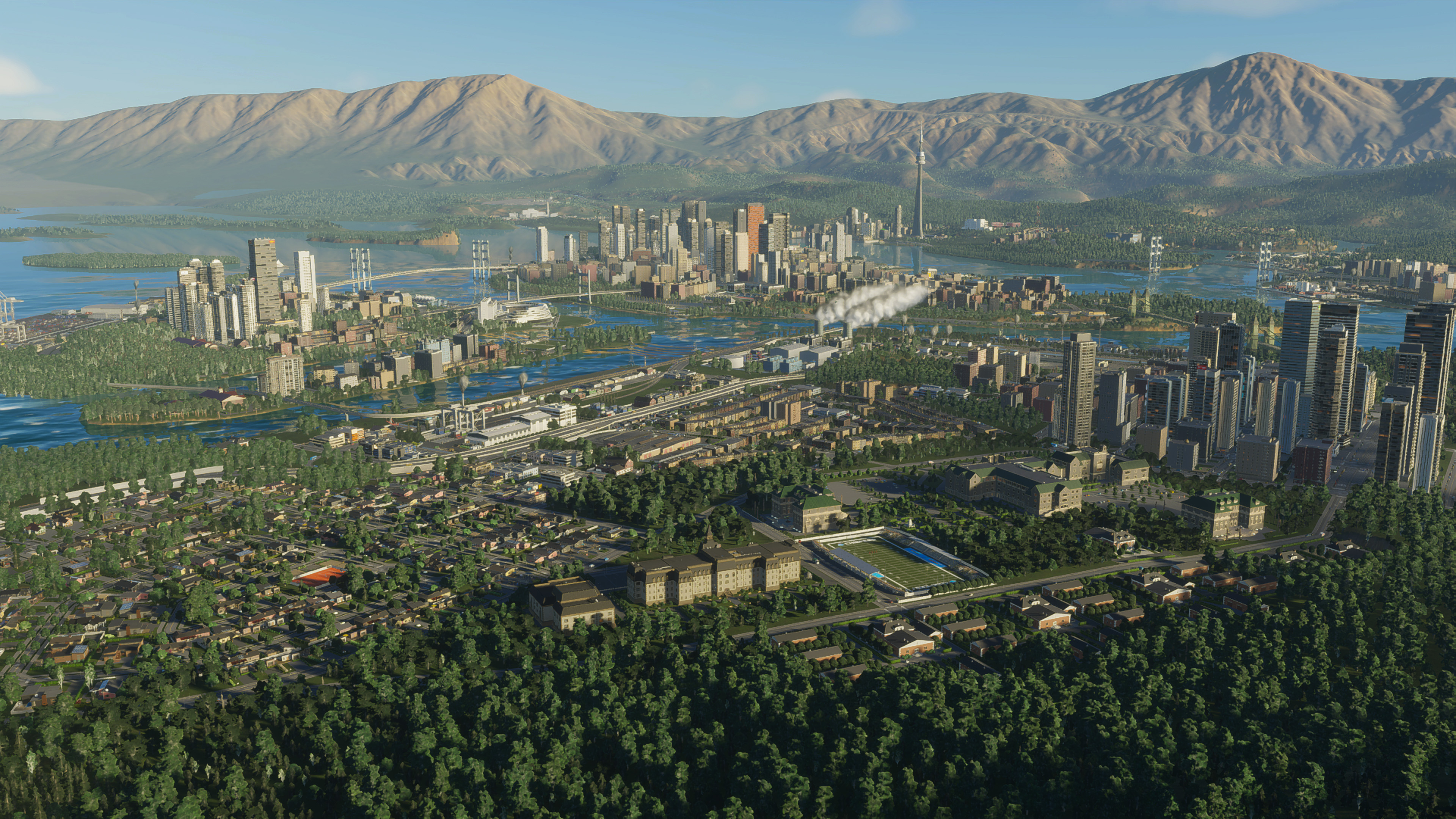
Terrible Optimization: Cities Skylines 2 GPU Benchmarks & Graphics Optimization Guide
Last Updated:
The city builder is an unoptimized mess but we help you navigate its settings and highlight which GPUs are best
The Highlights
- Cities Skylines 2 is the highly anticipated followup to 2015’s critically acclaimed Cities: Skylines
- The game is terribly optimized. The RTX 4090 is struggling to maintain 40FPS on 4K/low
- The game’s first post-launch patch improved performance, particularly for lower end cards, but there’s still a lot of room for improvement
- Original MSRP: $50
- Release Date: October 24, 2023

Cities: Skylines 2 is one of the worst-optimized games we’ve ever tested. Normally, we don’t like throwing around the word “optimized” -- but this one was bad enough that the developers themselves posted multiple panicked-updates ahead of launch to tell people as much.
In the time since launch, we’ve tested about 23 GPUs at multiple graphics settings and resolutions -- although we won’t bother presenting anything beyond 1080p, because the RTX 4090 was stuck below 40FPS AVG at 4K/low.
Today’s testing was done using a pack of save games published by City Planner Plays, a YouTuber who really focuses on the gaming side of this. City Planner did a good job with some initial benchmarks, and we’re here to pick up the torch for some in-depth performance and graphics analysis. We found everything from bugged texture quality that almost seemed inverse to the settings to bad stutters. The game itself appears to be getting updates, so that’s great to see. From what we can tell, it looks like a fun game that just needs some more time to bake -- and the fact that devs can increase performance within 2 days of launch proves that.
Credits
Test Lead, Host, Writing
Steve Burke
Writing, Research
Patrick Lathan
Camera, Video Editing
Vitalii Makhnovets
Writing, Web Editing
Jimmy Thang
Cities: Skylines II Performance Patch
Testing will be focused on a mix of comparative benchmarks and on one-off feature tests for optimization purposes. The developers specified some settings that can be tuned down for performance improvements, so we did some testing on those. We also tested each setting individually for maximum impact. We also have a section dedicated to comparing the visuals of some of the graphics presets so you know what you’re trading from one to the next.

Because the patch shipped after we’d done most of our testing, we went back to add it in. That gives us relative % scaling uplift that we can use to project the maximum uplift in the original tests. Now, with the current patch, a lot of these cards are still roughly in the same spot they originally were -- another 3-5 FPS won’t change the world in many cases, but it’s enough to help with specific cards, especially cards that are on the edge of playability.
GN 2022-2023 GPU Test Bench Specs
| Part | Component | Provided By |
| CPU | Intel Core i7-12700KF Overclocked (4.9GHz P-Cores, 3.9GHz E-Cores) | Bought by GN |
| Motherboard | MSI Z690 Unify | MSI |
| RAM | DDR5-6000 G.Skill Trident Z (manually tightened timings) | G.Skill |
| Cooler | Arctic Liquid Freezer II 360 @ 100% Fan Speed | Bought by GN |
| PSU | EVGA 1600W T2 Supernova Corsair AX1600i | EVGA Corsair |
| OS | Windows 11 | Bought by GN |
Research & Methodology: City Size
Let’s start with researching city size. We did this testing with our standard GPU test suite. We used the City Planner Plays files for this testing, so again, a massive thank you to him for posting some real gameplay save games to make testing easier.
As we get into testing, one of the most important aspects will be the city size. We were able to do like-for-like benchmarks at different city sizes. The weather and time of day conditions were all the same, as was the test course, so just the city developing was the change. The impact here is crazy. This was all conducted with the patch released on October 26th, which is the first performance patch.
This chart shows an RTX 4090 at 1080p/medium settings. The scaling is clean:
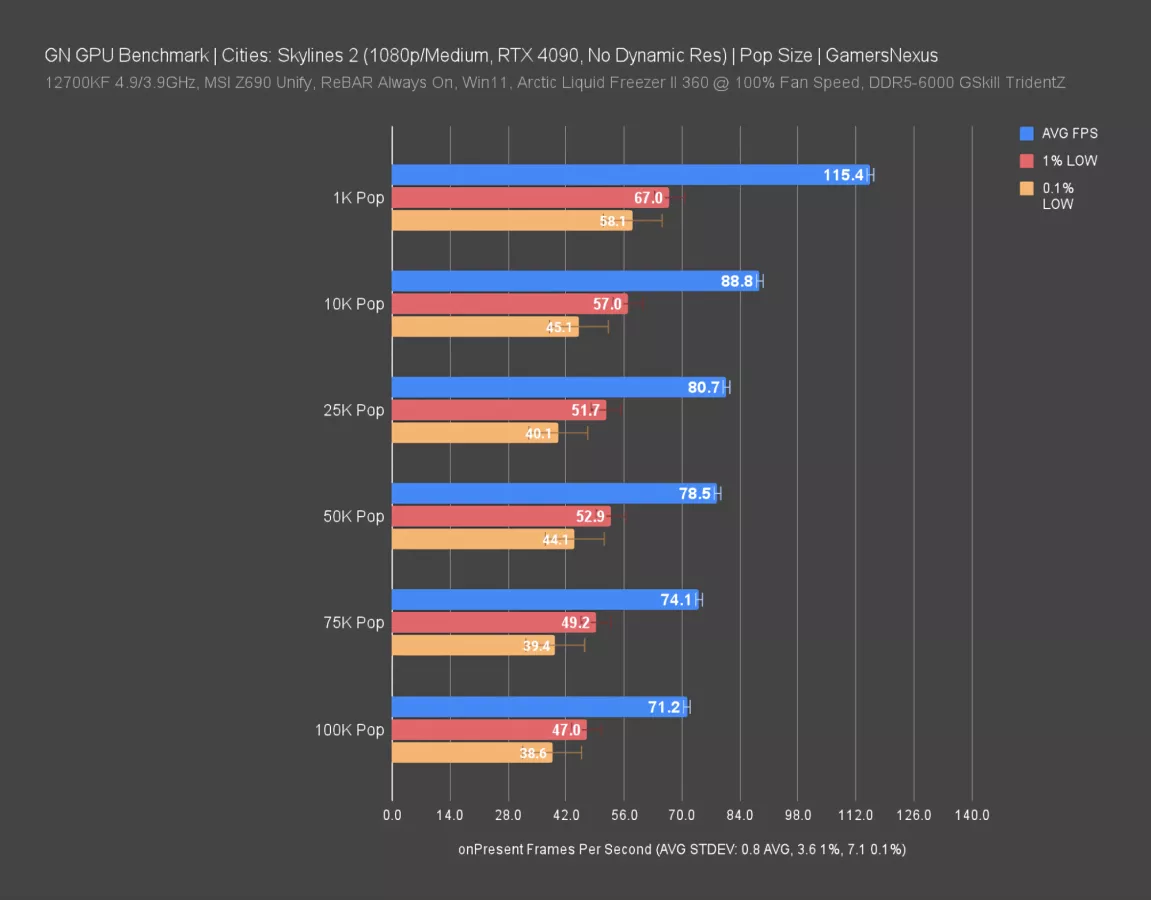
At 1K population -- pretty close to a blank map -- we’re at 115FPS AVG. That’s insane as compared to our 100K population map. That’s a 62% improvement if you were to demo your city down to a population of 1,000. To have a game with a 62% range is uncommon. We rarely see more than a 10-20% swing, with occasional 30% swings for heavy combat or effects.
In this game though, the longer your city is developed, the lower the framerate will be. We’re not sure at what point it stops scaling like this, but the performance degradation did appear to slow and become asymptotic as we approached 100K. The newer patch definitely helped smooth-out the frametime pacing on this card: Overall, the 0.1% lows here are much better than in the tests we’ll show from the older game version; however, the average framerate hasn’t moved much.
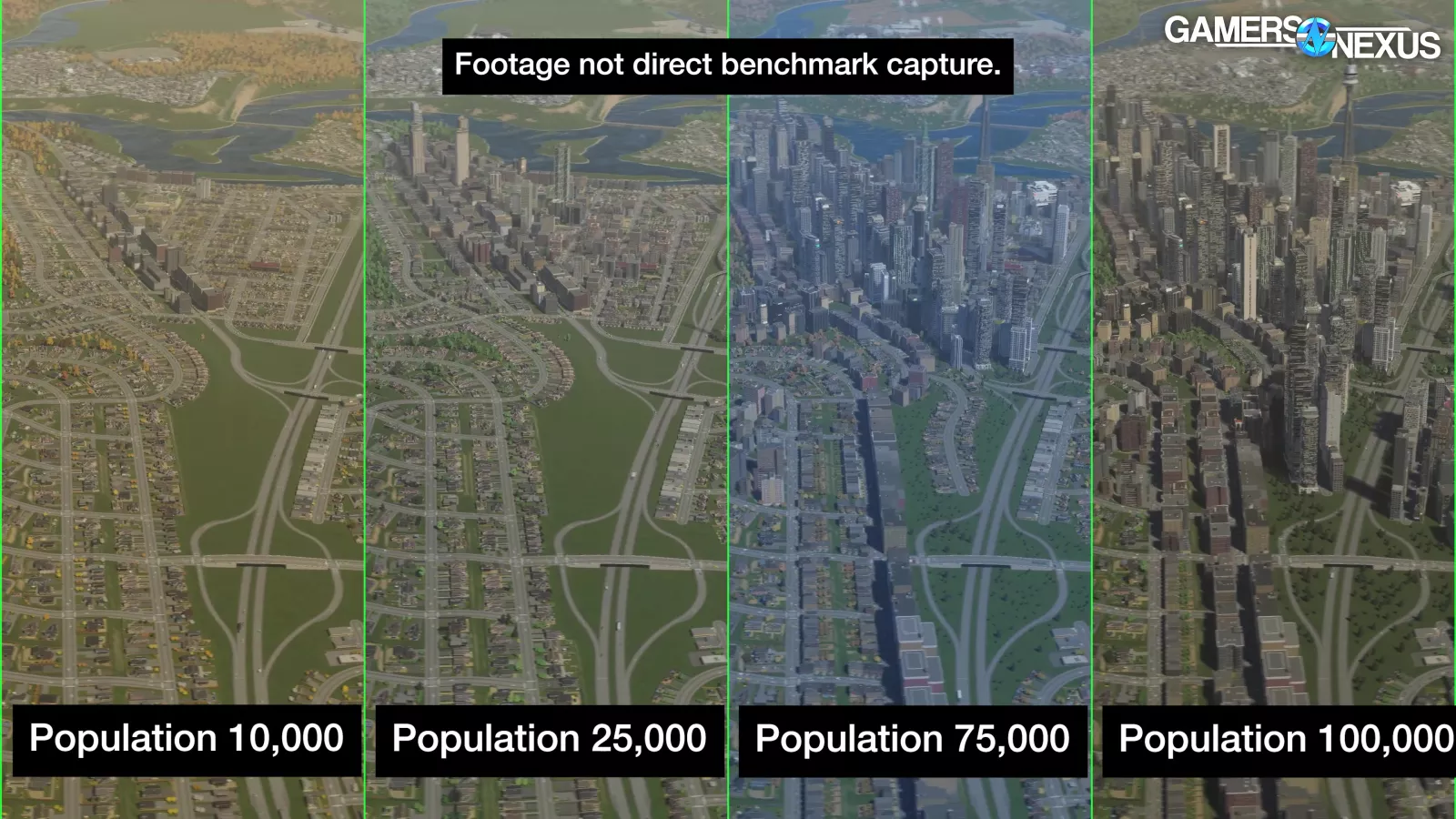
The 100K map was used for our testing, as it’s a heavier workload while still representing a realistic gaming scenario.
We’ll come back to more research after the comparison charts to show some graphics and performance optimization tips for Skylines 2.
Cities Skylines 2 Updates & Benchmarks
We’ll start with the impact from updates. Colossal Order posted this:
While this does not address all issues we are aware of, we wanted to get you these improvements as soon as possible.
Colossal Order
The changelog included these notes:
- Changed LOD to be independent of rendering resolution to get more consistent performance with high resolutions
- Minor optimization with fog
- Depth of field optimizations and tweaks
- Global illumination tweaks
- Optimized stutters when buildings spawn/level up
- Optimized various stutters across all systems
- Fixed crash after upgrading wind turbine
- Fixed crash when car crashes into still hidden car with trailer
- Fixed crash with mesh loading (that happens with low settings mostly)
When the update launched, we were actually already filming our video. We decided to pause the entire project to investigate the new patch, but this was after we’d already tested about 23 GPUs in several different graphics settings, amounting to about 500 test passes. The update included some specific notes on stutters and on LOD at higher resolutions, alongside some global illumination changes.
Let’s start with the impact from the patch alone, just showing a small subset of GPUs.
Cities Skylines 2 Launch vs. Patch Performance
1080p/Low, No Dynamic Resolution
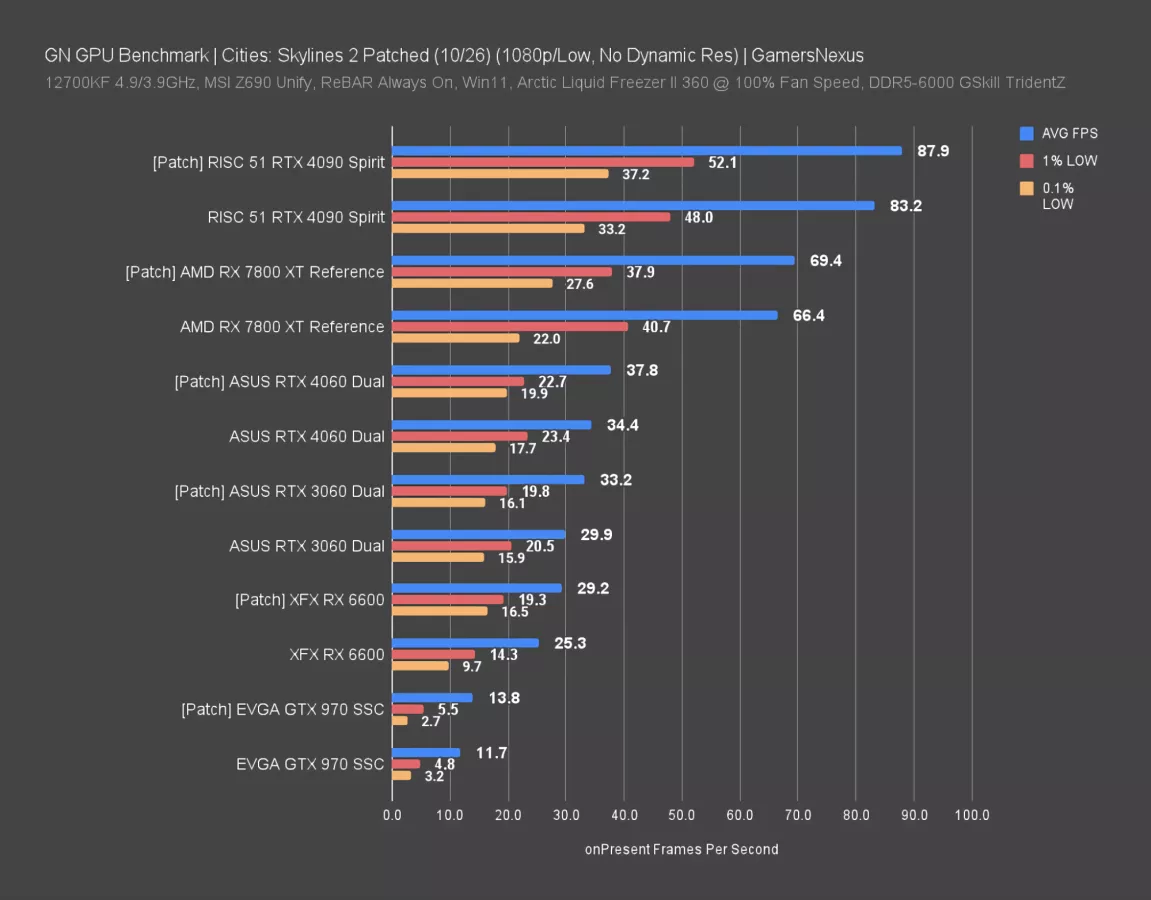
In this chart, you’re looking at the original passes versus the patched passes. At 1080p/low, the RTX 4090 posted a 5.6% performance uplift. That’s not much, and we’re not at the CPU limit yet -- that happens closer to 112FPS AVG. The RX 7800 XT posted a 4.5% improvement in average FPS. That’s good, but from the perspective of our original round of tests, not much has changed. You can approximate these differences. The RTX 4060 saw an improvement of 9.8%. That’s more meaningful than the prior two. The 3060 posted the most meaningful uplift yet, at 11%. That moves it from 30FPS AVG to 33FPS AVG.
Not game-changing, but at least it’s better.
At the lower end, the RX 6600 posted about a 15% uplift, from 25 to 29FPS AVG. The GTX 970 was unplayable with these settings originally and remains unplayable here. The uplift was massive as a percentage -- almost 18% -- but that just means it moved from 11.7 to 13.8FPS AVG (and with a standard deviation on this specific card of 0.4FPS, that’s part of it).
The trend here is that the worse the card did, the more uplift it got. There was more ground to gain. Even without a CPU bottleneck, higher-performing cards just didn’t benefit as much -- they weren’t bound in the same way.
As for frametimes, there was improvement in most of the cards. Not always, but generally speaking, it is better.
Now we’re going to run through the original performance numbers pre-patch, but keep these numbers in mind to help calibrate against the newest version. This data will still help you figure out what cards make the most sense, as most were impacted in the range of 5-10%. You won’t see more than that typically unless under 30FPS already, at which point it’s already borderline.

Cities: Skylines 2 1080p/Medium Settings
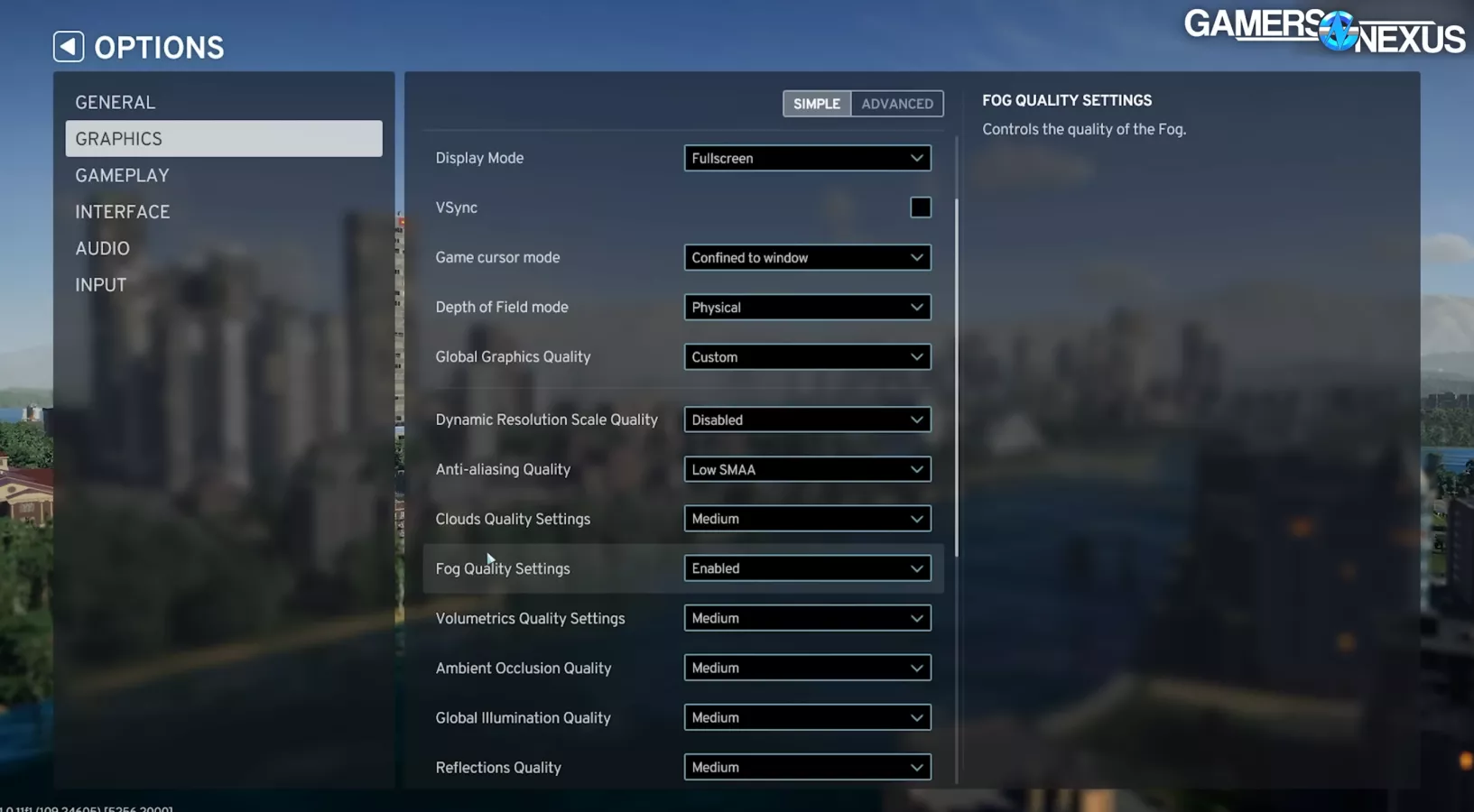
Here’s what the options look like. When using presets, medium enables dynamic resolution scale quality as automatic. For our testing, we always toggled dynamic resolution off as dynamism impacts testing and removes like-for-like comparisons. As for the rest, medium predictably sets nearly every option to “medium.” Anti-aliasing is set to low SMAA, but everything else just says “medium.” Simple enough.
Cities: Skylines 2 1080p/Medium Benchmarks
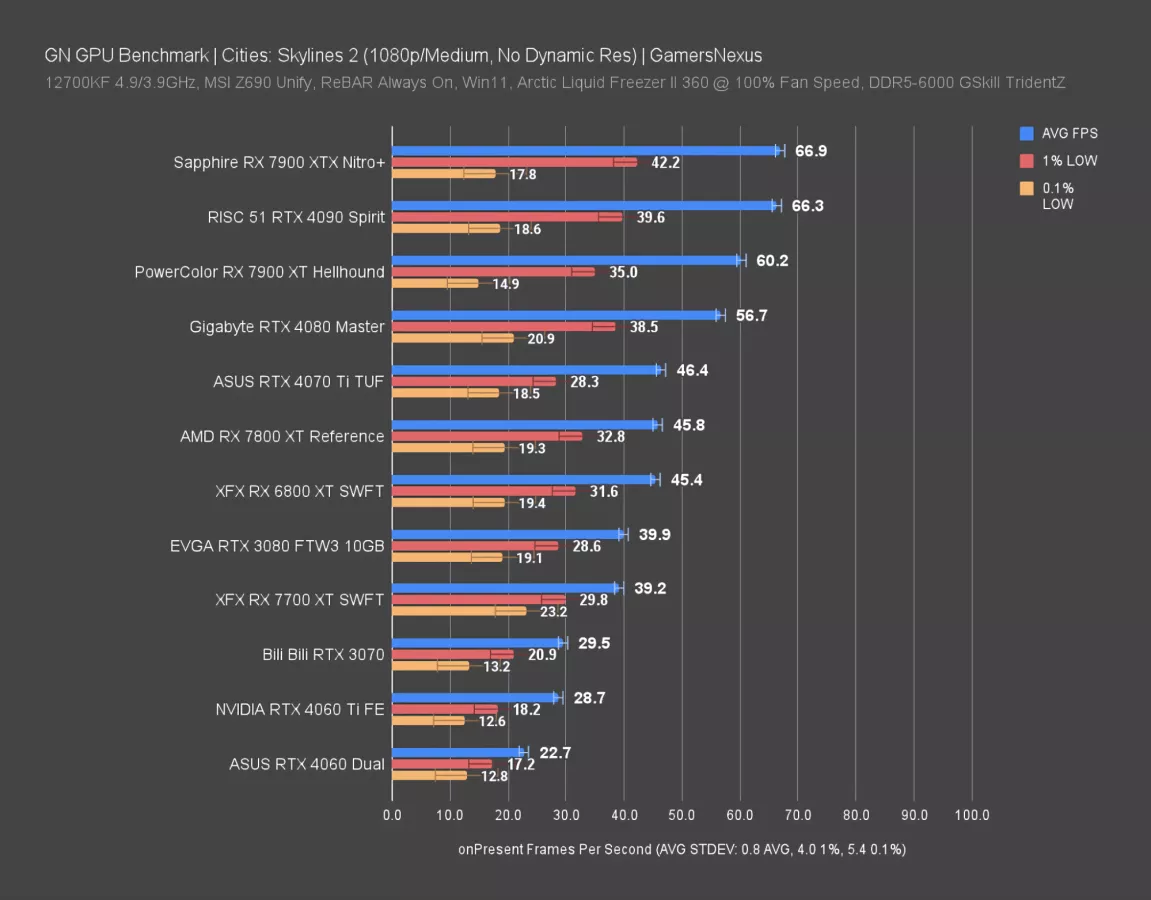
At 1080p and with the medium preset, the RX 7900 XTX sets the ceiling at about 67FPS AVG. Lows are paced better here than they were at other graphics configurations, with more consistent frametime pacing. They’re still not great, evidenced by the wide gulf between 67FPS AVG and 18FPS 0.1% lows, but that’s far better than the single-digit entries we saw in some other presets.
The 4090 is tied with the 7900 XTX here. They are indistinguishable. The cheaper RX 7900 XT trails, giving the XTX model and RTX 4090 about an 11% advantage. We also recently revisited the RX 7900 XT and found it to be a good value with its new price drops. The RTX 4080 follows that, where the 7900 XT holds a 6% lead.
Progressing through the list, the 4070 Ti ran at 46FPS AVG, where the 4080 has a 22% advantage. The 7800 XT is functionally tied with the 4070 Ti in AVG FPS. The lows are also about the same -- although we had a single pass of the 4070 Ti where its lows tanked. But as we said earlier, that seems to be almost chance as to whether such a spike occurs in a run.
The 6800 XT is about tied with the 7800 XT, which makes sense: In our review, we found the 6800 XT was often ahead of the 7800 XT at higher resolutions, but otherwise was commonly tied.
After this, the game’s recommended RTX 3080 landed at 40FPS AVG, just below the 6800 XT. The low-end of the chart is built by the RTX 4060 at 23FPS AVG -- it could be made to work better with lower settings -- and the 4060 Ti at 29FPS AVG represents a 26% jump.
Cities: Skylines 2 Stutters & Lag (Frametimes)
The first thing you need to know is that the frametimes in this game are completely crazy. This has gotten better with the first patch, but it’s still bad -- it depends on which card you use and at what settings.
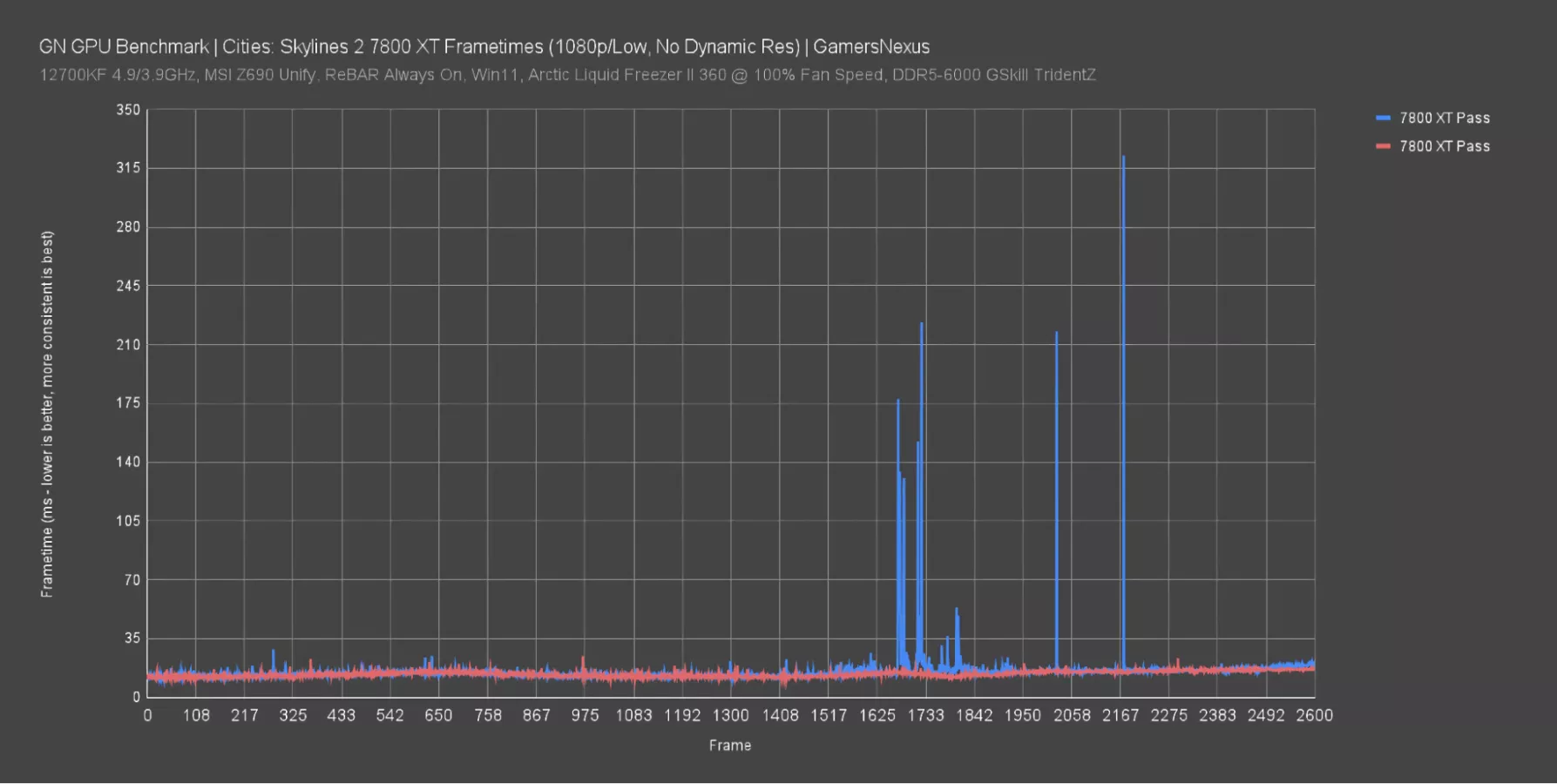
In fact, here’s a look at the RX 7800 XT after the patch that helped with stutters. This is at low settings. One of these two passes had several violent stutters over 100ms, including one spike to 322ms. That’s one-third of a second that we’re staring at the same frame, so this is still a big problem. The other pass we’re showing here is more stable -- so the game can run smoothly, but it’s not reliably smooth.
The point is that 1% and 0.1% lows are not an indicator of card quality this time because the game is so variable, so they’re more an indicator of game behavior.
Cities: Skylines 2 1080p/Low Settings
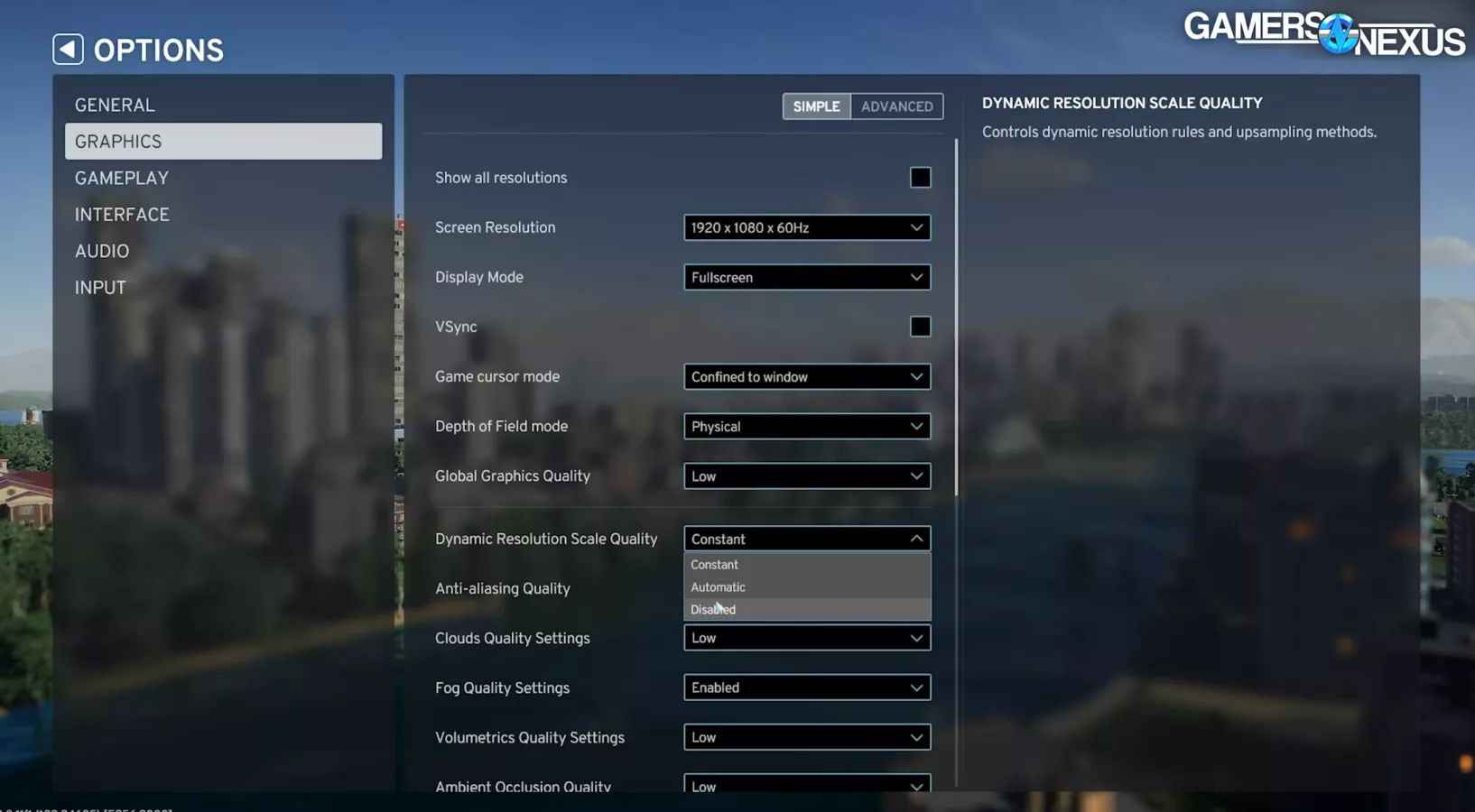
We’ll next look at low settings. The preset option toggles dynamic resolution scaling quality to “constant” -- but again, we disable that for testing so we have comparable data -- and otherwise, almost every option is set to “low.” Anti-aliasing is set to FXAA, fog is enabled, and animations are set to their lowest option, which is medium.
Cities: Skylines 2 1080p/Low Results
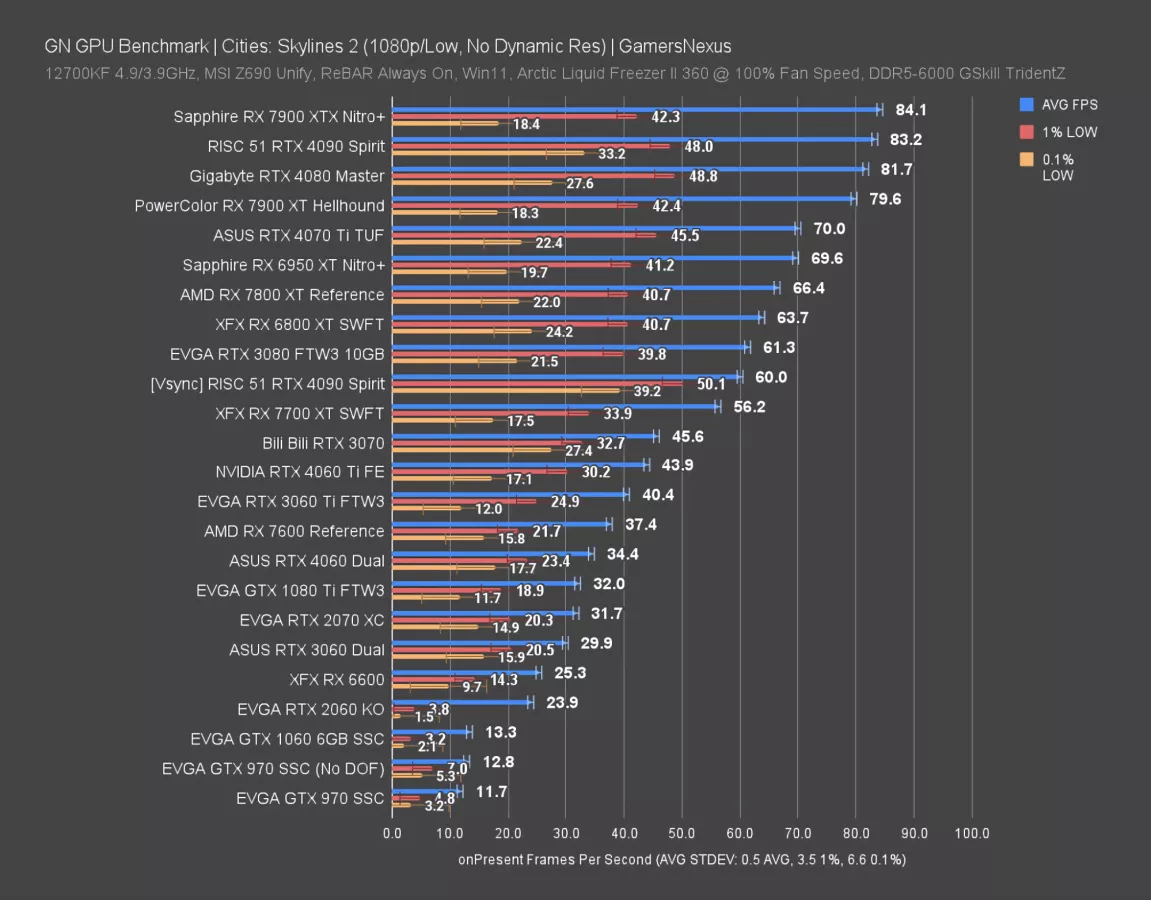
Here are the results for 1080p/low. The top of the chart is pinned to around 83FPS AVG, with the 4090 and 7900 XTX at the front and closely trailed by the RTX 4080. This matches what we saw at medium.
If we were to draw a line at around 30FPS, then the RX 6600, and everything below it falls short and would need further settings reductions. This includes the RTX 2060, GTX 1060, and on a technicality, the RTX 3060 -- although 29.9 is effectively 30 FPS AVG, assuming you’re OK with that framerate in this game.
While these cards were more playable in the lower population cities or empty maps, they suffered greatly as the population count and city complexity increased.
Shifting focus back towards the rest of the chart: The Skylines 2 community seems to be regularly talking about Vsync. We’re confused why, because this setting isn’t anything new nor does it behave in a different way in Skylines. It is completely normal behavior. We ran it on a 4090 just to reiterate an ancient point: Vsync will cap to the screen refresh rate, so on a 60Hz display, that’ll be a 60FPS maximum value. That’s exactly what we got. Doing this can help eliminate frame tearing, but will introduce potential stutter problems in scenarios where frames are not ready on the flip interval. Nothing new there, though. In this scenario, the 4090 is sufficiently fast against a 60Hz refresh, leaving it able to more evenly pace frames and be less constrained overall.
The RTX 3080 ran at 61FPS AVG here. That’s the card the developers recommend. The GTX 970 was its minimum, which struggled hard: Even at 1080p/low, we could barely exceed 11FPS AVG. Turning depth of field completely off and setting depth of field Quality to off -- just for good measure -- we saw an increase of 9% to 12.8FPS AVG. That doesn’t really help. We’ll revisit this card at very low.
The 7000 series RX GPUs seem more advantaged here than we’ve seen in some other games. The RX 6800 XT generally outperforms or more closely equates the RX 7800 XT, largely because of its CU count advantage, but we’re seeing the 7800 XT pull ahead in these charts. The same goes for the 6950 XT and the 7900 XT, where we’d normally see them closer together or sometimes flipped.
Cities: Skylines 2 1080p/Very Low Settings
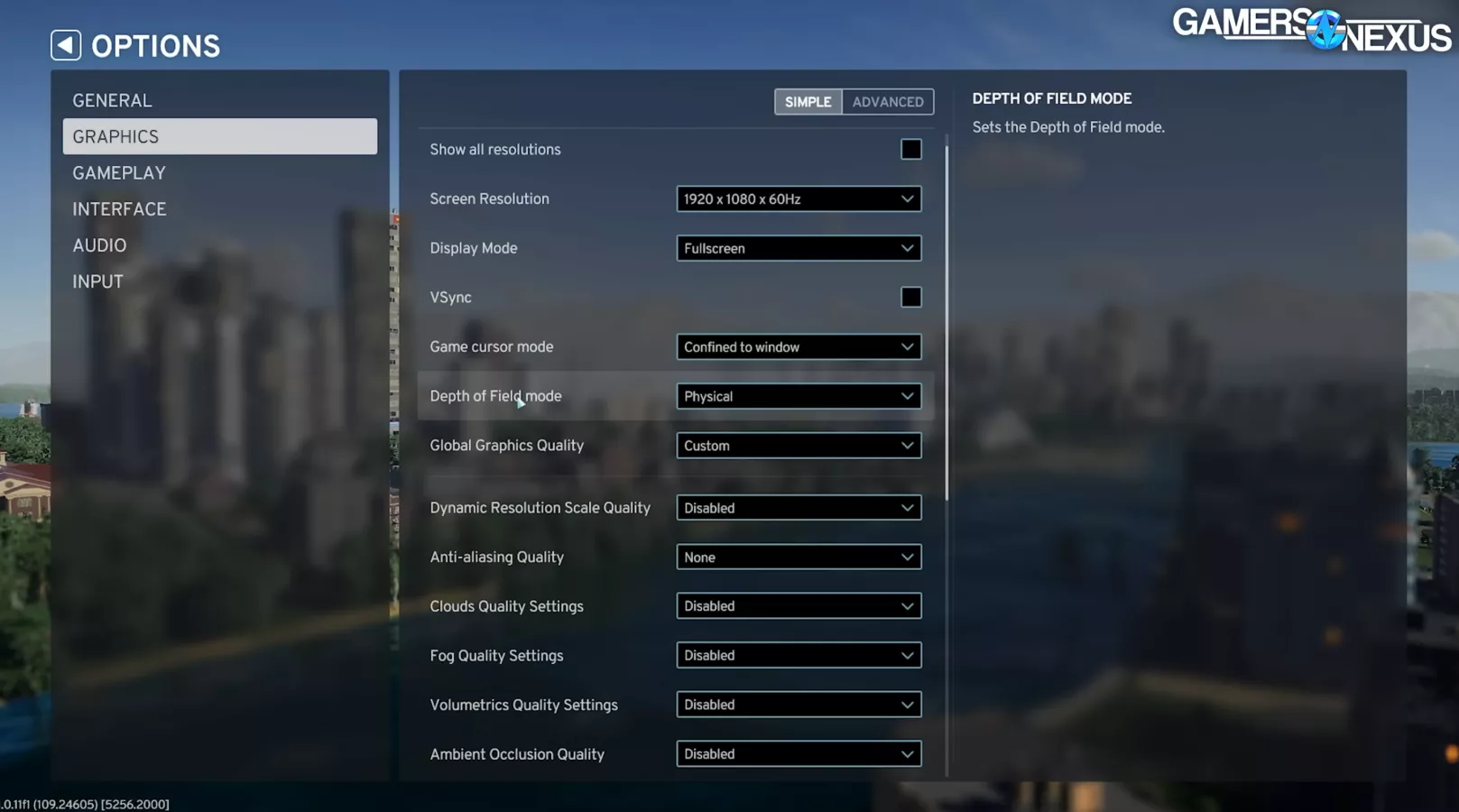
“Very low” configures almost everything to a simple state of being toggled off. Anti-aliasing is disabled, terrain quality is set to low, water quality is set to low, LOD is also low, and animations are medium.
Cities: Skylines 2 1080p/Very Low Benchmarks

First off, we’re becoming bound at about 110FPS AVG. Everything from 104FPS to 112FPS is at least occasionally hitting other limitations, which means we aren’t seeing the true GPU performance here. You cannot declare any one of these is better than the other based on these numbers. We’re bottlenecked. Of course, realistically, a framerate this high in Skylines just means you should increase the quality, at which point you see them diverge as shown in our earlier charts.
Let’s start with the GTX 970. With every single setting toggled to its lowest configuration, except depth of field at Physical, we’re seeing a result of 28FPS AVG. Maximally, a DOF toggle would gain you 2-3 FPS here, for a possible throughput of about 30FPS AVG. The lows are bad, though: You’re going to encounter stuttering frequently, and in particular, rapid zooms or camera movements will provoke them. On a technicality, this card is playable. You might want to reduce resolution though.
Because this game seems best played at 1080p, the RTX 3060 Ti is actually beaten by the RTX 4060 Ti. You might recall that memory bandwidth limitations on the RTX 4060 Ti were severely hampering it generationally, which often results in regressive performance against the 3060 Ti when resolution is increased. We found that the 4060 Ti almost universally lost to the 3060 Ti at 4K. At 1080p though, it’s ahead.
The GTX 1080 Ti is sticking around too, holding 72FPS AVG at the lowest preset. AMD’s newer RX 7600 is roughly tied with the 1080 Ti. You’d be able to increase settings quality on these cards. The 3060 is positioned similarly, as is the 2070. As for the 4060 non-Ti, that leads the closely competing RX 7600 by about 10%.
The biggest thing we saw here though was better frametime pacing. Although not great overall, most of these cards are at least in the 30s for 0.1% lows. The RTX 2060, GTX 1060, and GTX 970 all had highly variable lows. Remember again that these don’t necessarily tell us which card is better than the next if it’s highly variable: Although that is true higher up the stack, these weaker cards struggle. What it really tells us is that they’re struggling with consistency in this game, and that’s due to the heavy workload.
Cities Skylines 2 Graphics Settings Explained & Compared
Image Quality Comparison: Very Low vs. Low
Cities: Skylines 2 Optimization Research
Our next chart looks at individual graphics settings. For purposes of this test, we only had one objective: Pick a card at about 30FPS AVG when at baseline 1080p/low, then tune the settings down individually to identify what helps the most. The reason we chose “low” as a baseline is because the gap between low and very low is gigantic. On the GTX 1080 Ti, that meant moving from 32FPS AVG to 72FPS AVG. That is MASSIVE. We normally see swings closer to 10% in games between settings -- Starfield was almost perfectly 10FPS per preset. In this game though, the gulf between very low and low is wide enough that you could shove a 4090 through it. That means there’s a lot of room to make the game look better for players who can’t play low, but have framerate that’s excessive on very low.
We didn’t do this for every card. If we did, it’d have been 322 combinations just to test low against very low and off individually. But this does appear to be largely scalable as a percentage, so even with one case study on the GTX 1080 Ti, you’ll have enough to apply that knowledge to your own GPU.
Cities: Skylines 2 Settings Optimization
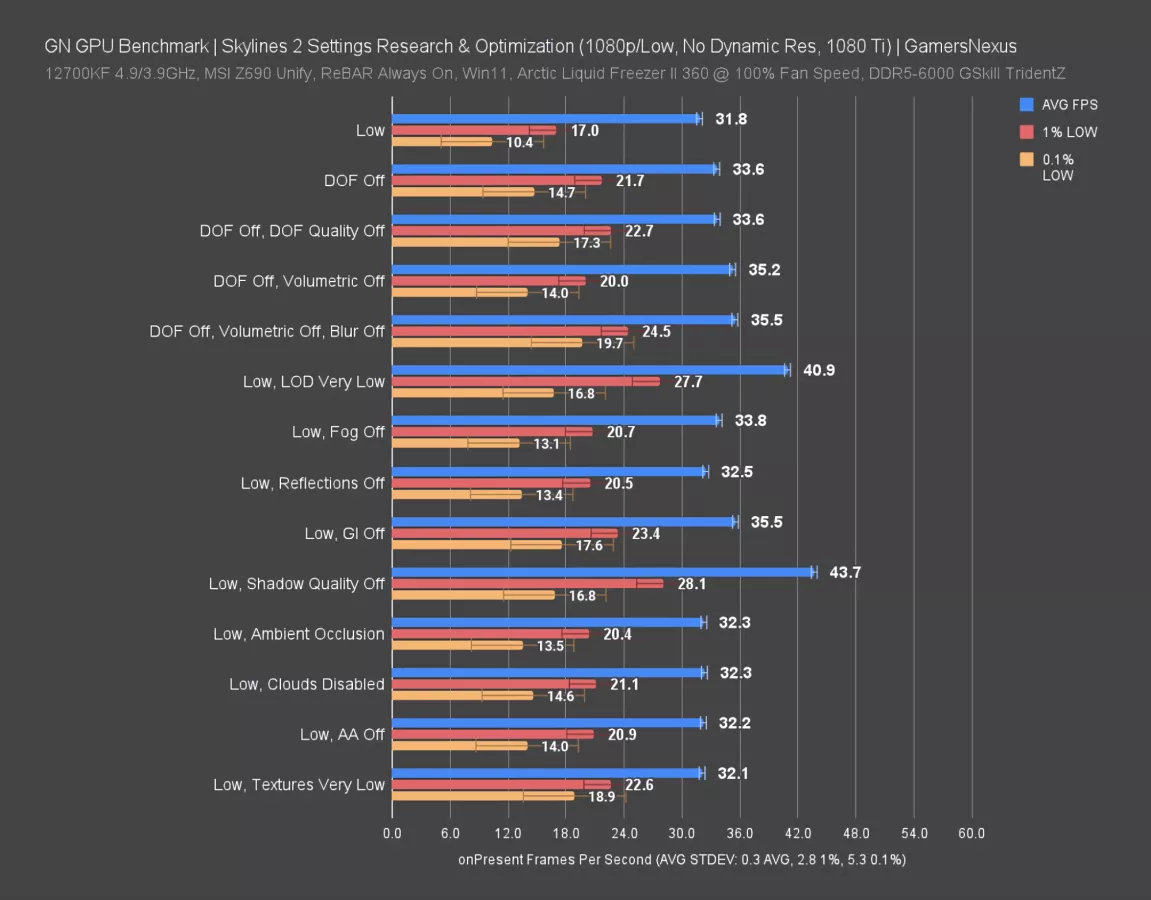
Baseline low with dynamic resolution off is at the top. Toggling depth of field completely gave us a 33.6 FPS AVG for both variations. The first was toggling it from baseline Physical to off, the second entry in the list was also toggling the quality to off (which presumably should do nothing when the setting is off altogether). That’s an improvement of 5.7%. On the 970 earlier, we saw closer to 10% -- but the framerate was also much lower, so the impact may have been disproportionate.
Each entry only changes the setting listed, so DOF remains on Physical for the rest. That means you compare each line item against the top “low” entry, but not the prior entry.
Turning off volumetric effects got us to 35.2, a boost of about 11%. That’s significant and could be a place to find a lot of extra performance. We also did a test with the Colossal Order recommended settings, so depth of field off, volumetric off, and motion blur off. There was functionally no impact as compared to the prior tests. Volumetric alone achieved similar results. The gains didn’t stack here -- or not by much. We did get a stacking effect materializing in the frametime pacing, though: You’ll notice that improved markedly.
The two biggest impacts came from level of detail and shadow quality. That’s normal in a game: shadow quality jaunted us in huge ways, gaining us 37% performance. Level of detail scaling, at least for the launch-day patch, boosted us 29%. As for ambient occlusion, clouds, anti-aliasing (from FXAA baseline), and texture quality (on a card with sufficient VRAM), none of those really affected things much. You could leave these at low or boost them higher to increase fidelity without much loss of framerate. Fog boosts framerate when disabled, and since some people seem to really hate how the setting looks anyway, that’s potentially a win-win. Reflections didn’t do much in our test environment, but might have more impact in other specific scenarios. Global Illumination was alongside volumetric as having moderate gains.
Cities: Skylines 2 Updated Settings Research
Time to look at how the first patch affected the game. We re-ran a few of our tests to quickly check on if the scaling we saw in the last chart changed.
We re-ran tests for the baseline low result, depth of field, and global illumination. We had to limit the time re-investment since we’re already 3 days into this piece, and these are some of the specific settings that were named in the update without getting into resolution scaling from LOD.
The low baseline improved to 35.6 from 31.8, or an uplift of about 12% in this configuration. The original depth of field toggle was a 33.6 FPS AVG, an uplift of 5.7% on this card. The patch boosted that to 36.6 FPS AVG, so we’re only seeing a 3% uplift now. You can’t compare the unpatched low baseline to the patched depth of field toggle. That wouldn’t be relevant. The improvement is less significant now than it was before, which suggests changes to depth of field at baseline.
The global illumination toggle previously improved performance to 35.5 FPS AVG, an uplift of 12% against the original baseline. The new result is 38.2, an uplift of 7.3% against baseline. The reduced improvement again aligns with the patch’s changes to global illumination. This game is still performing poorly overall, but the patch brought a huge improvement. They really should’ve had the two extra days to push this prior to launch.
Cities: Skylines 2 Shadow Quality Comparison
Because shadow quality had some of the biggest impact on performance, we’ll spend some time showing a side-by-side of the setting. This is only comparing the low option versus the toggled off option.
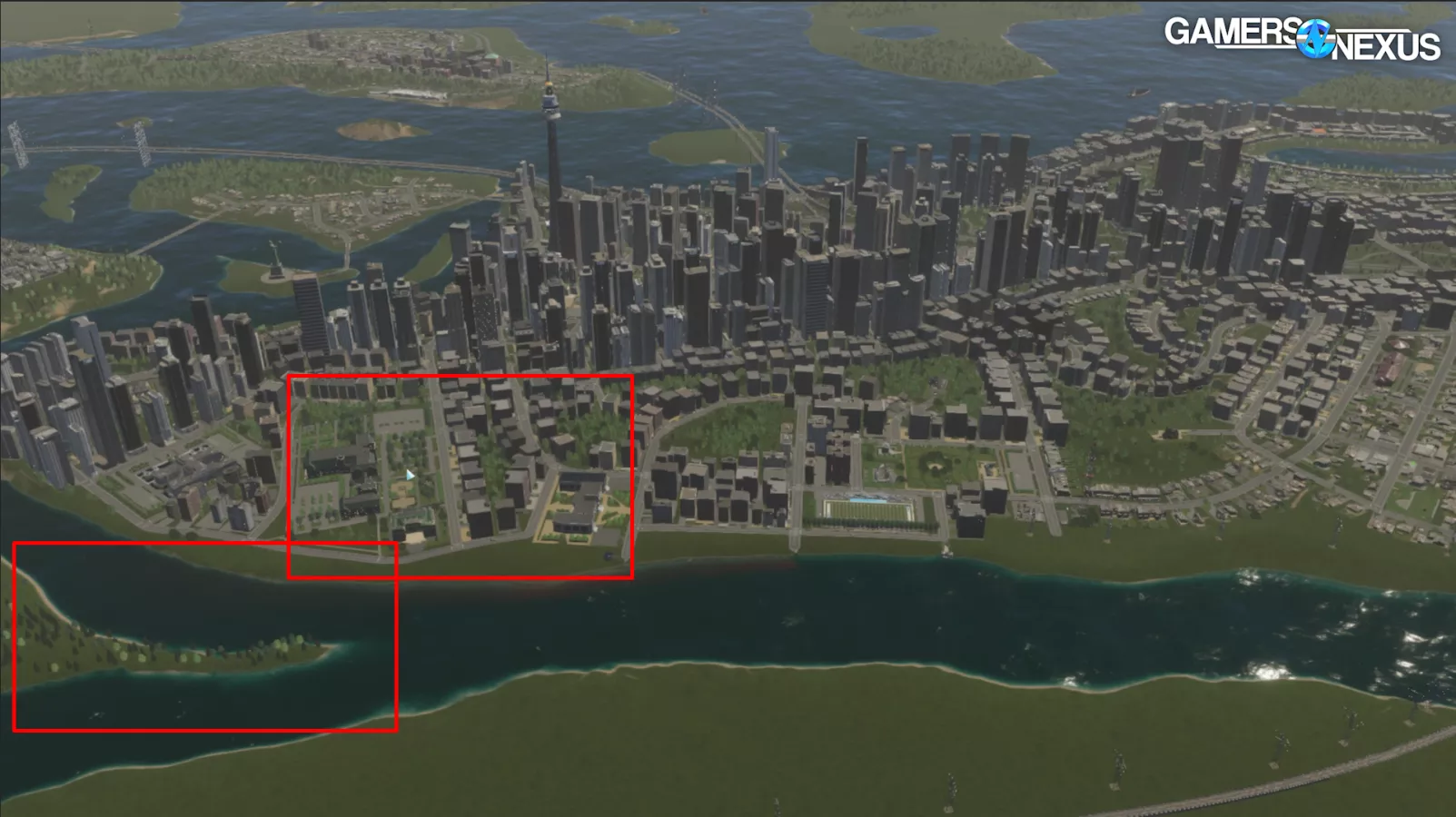
When shadows are toggled off, you’ll notice the three-quarters angle of the city lacks any shadowing at all on the trees in the lower left corner. The park centrally also shows this well, where we have a very flat-looking image. They should just call this option “Sim City 3000.”
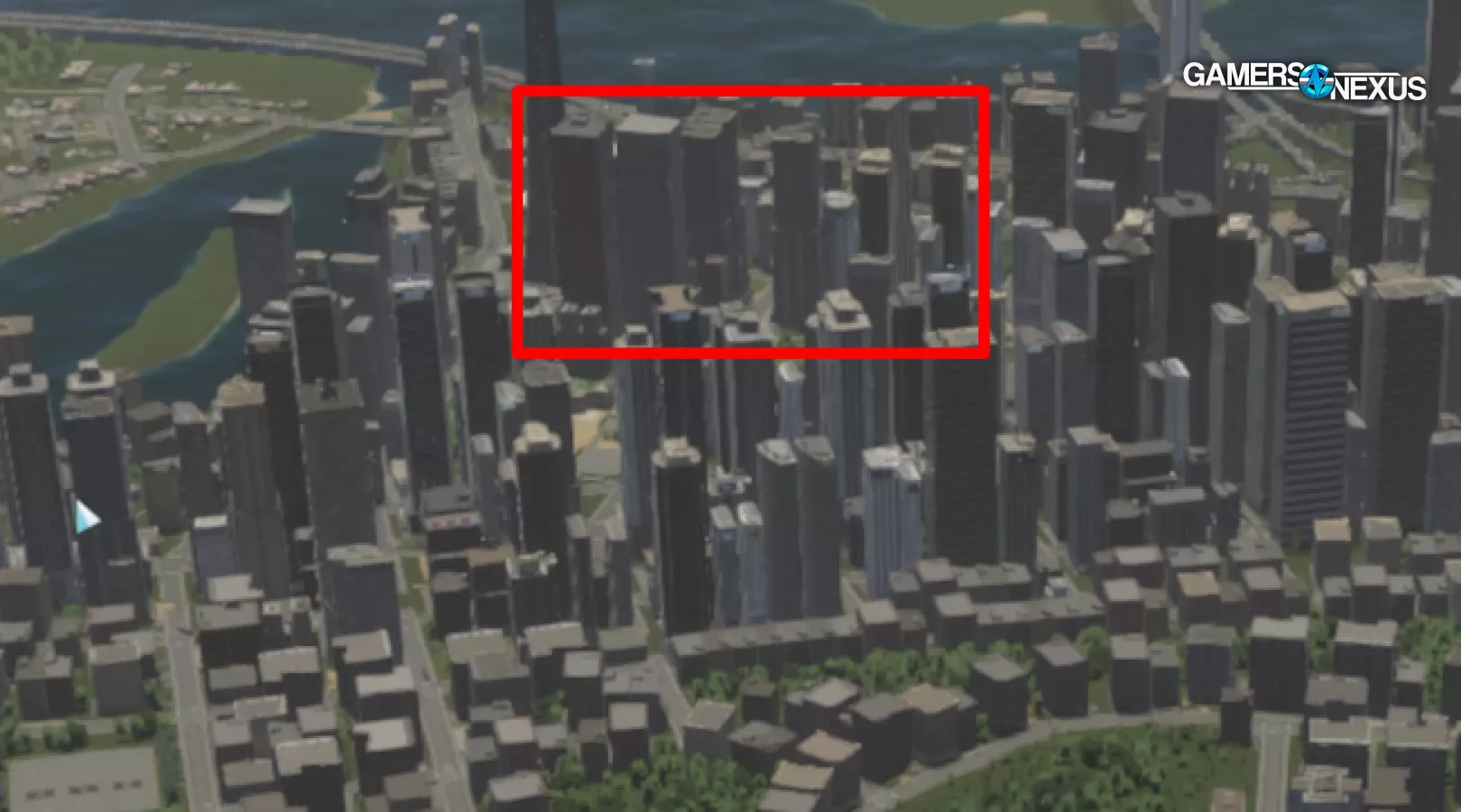
Looking at the buildings in the city, we can also see a removal of shadows along the inside walls of the buildings. Toggling it on and off a few times, you can really see the impact of even just going to low shadow quality. But remember, on our 1080 Ti case study from baseline low, the cost was 37%.
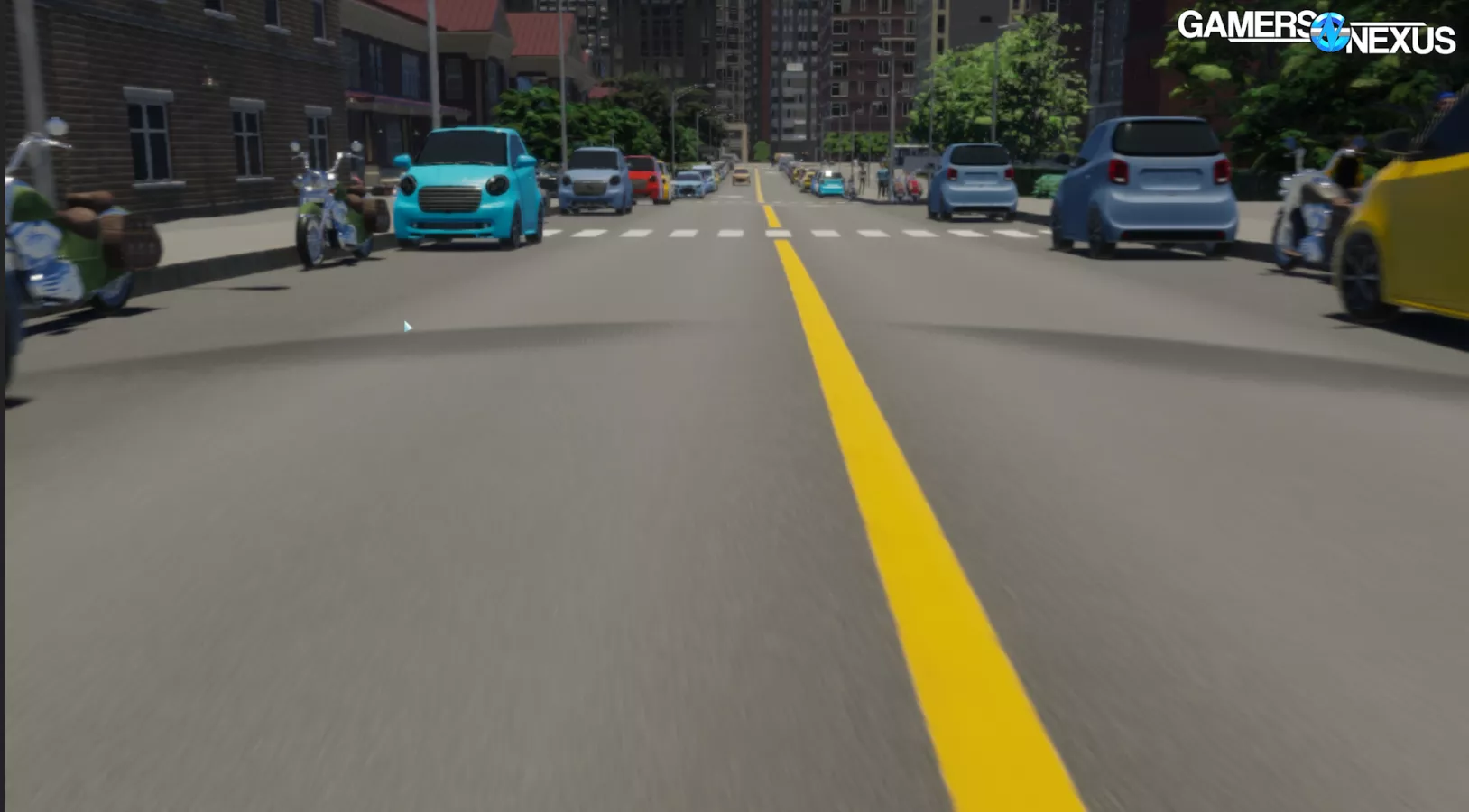
Zooming-in to the city makes this really apparent. The absence of shadows is clear here, so we probably don’t need to point-out the individual examples. The car undersides make it particularly obvious, but even the curb has shadowing when this close to the street.
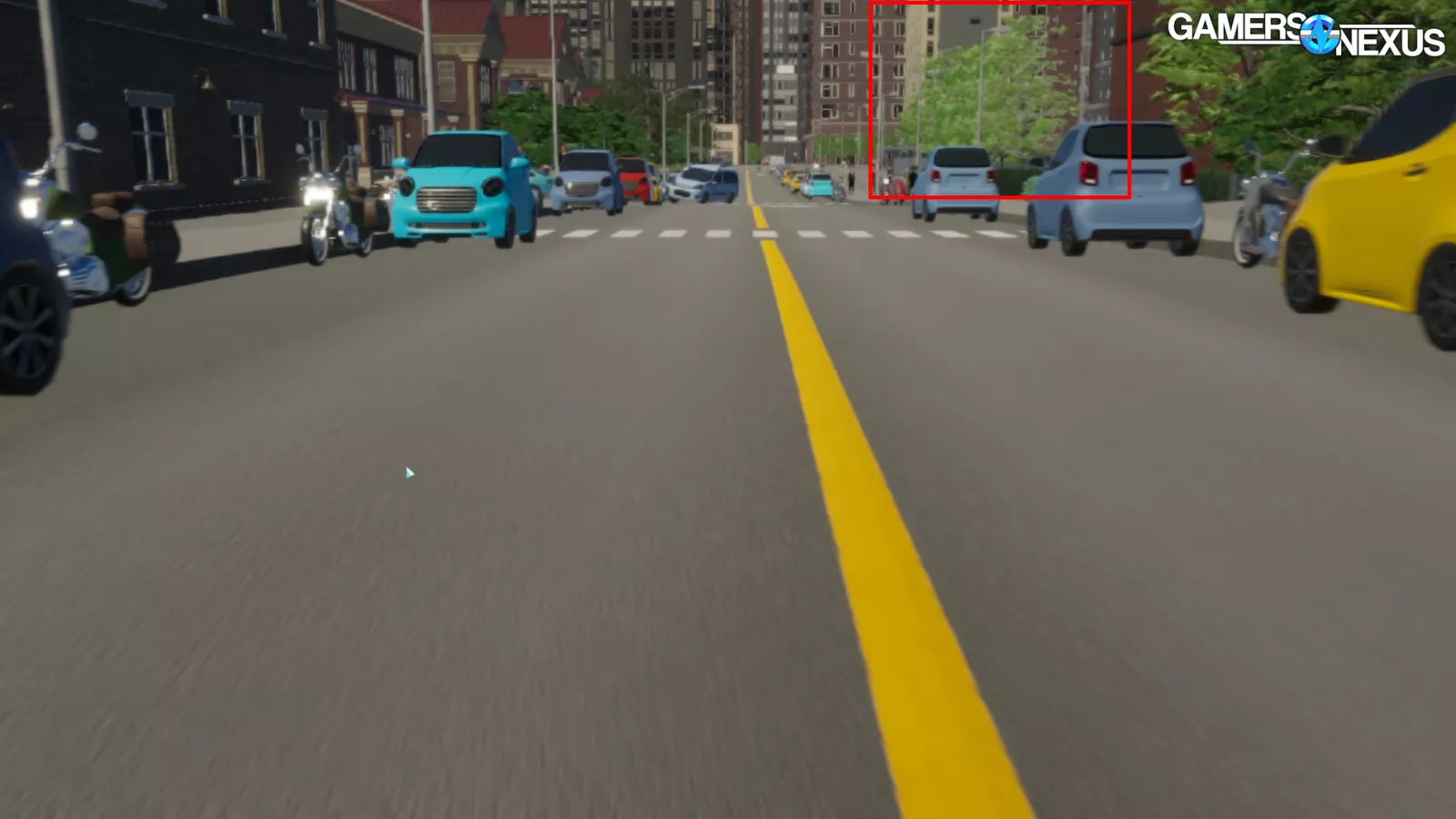
It’s also clear in the trees in the background, where toggling shadows off removes any depth or self-shading from the leaves and canopies.
If you’re desperate for performance, you should turn this option off. But unlike settings where there’s sometimes no visual improvement for a high performance cost, this one does have a visual change that’s tied to the performance impact.
Cities: Skylines 2 Preset Comparison
| Very Low | Low | Medium | High | |
| Anti-aliasing Quality | None | FXAA | Low SMAA | High SMAA |
| Cloud Quality Settings | Disabled | Low | Medium | High |
| Fog Quality Settings | Disabled | Enabled | Enabled | Enabled |
| Volumetrics Quality Settings | Disabled | Low | Medium | High |
| Ambient Occlusion Quality | Disabled | Low | Medium | High |
| Global Illumination Quality | Disabled | Low | Medium | High |
| Reflections Quality | Disabled | Low | Medium | High |
| Depth of Field Quality | Disabled | Low | Medium | High |
| Motion Blur | Disabled | Low | Medium | High |
| Shadow Quality | Disabled | Low | Medium | High |
| Terrain Quality Settings | Low | Low | Medium | High |
| Water Quality Settings | Low | Low | Medium | High |
| Level of Detail | Very Low | Low | Medium | High |
| Animation Quality | Medium | Medium | Medium | High |
| Texture Quality Settings | Very Low | Low | Medium | High |

Comparing the presets now, we're going to split our benchmark course into a few scenes and cover them in order. Keep in mind that changing the presets changes every setting simultaneously, so in this section, we can't definitively say that any one change we notice corresponds to one setting. Note that resolution scaling was intentionally disabled for these tests, although it would normally be a part of each preset.
Starting with a wide shot of the city, the first visible difference is the lack of fog at the very low preset. Fog quality is simply marked "enabled" at every other preset, and it doesn't change in appearance between them, but at very low, the full-screen haze is completely gone. Frustratingly, the fog gets in the way of most of the other settings we want to compare.
Graphics Quality Preset Comparison: Very Low vs. Low, Medium, High
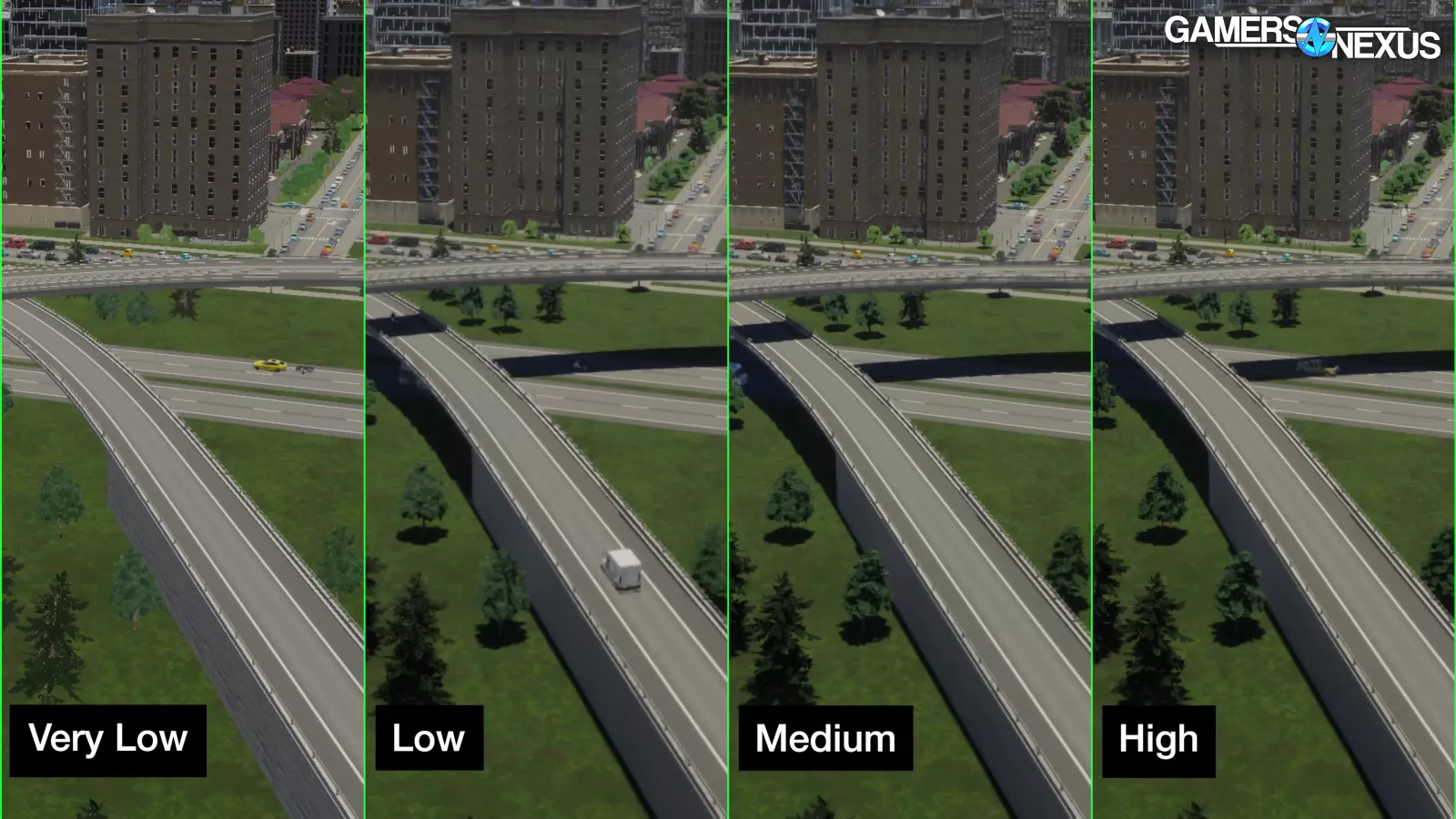
This should help us determine if it's worth using higher presets. The next most obvious change is shadows again, with very low automatically setting shadow quality to "disabled." We won't waste time rehashing that: no shadows means no shadows. At this distance, though, even the differences between quality levels with shadows enabled is unclear. Neither the draw distance nor softness of the shadows changes visibly. We'll check back on that once we zoom in.

Interestingly, there's a clear increase in the quantity of distant trees when moving from the very low to the low presets, but no change above that. Out of the given settings, we'd suspect that trees are governed by LOD or maybe terrain quality, but each of these settings is supposed to scale up with presets above low.
The highlighted power lines between the pylons crossing the river pop in sooner at medium and high, but we haven't played much Skylines and it's unclear to us whether these highlights are even intentional.
With a ton of qualifiers (in this relatively flat city, on a sunny day, without any water-related disasters, at this distance, at this resolution), we haven't seen a meaningful difference between low and high presets so far. Let's keep looking.
Continuing to pan around the city, there are clearly visible reflections of bridges, roads, and boats on the surface of the river at the medium and high presets, but not below that. Reflections move from disabled with the very low preset to low at the low preset, but evidently the lowest tier of reflection quality doesn't include these elements.
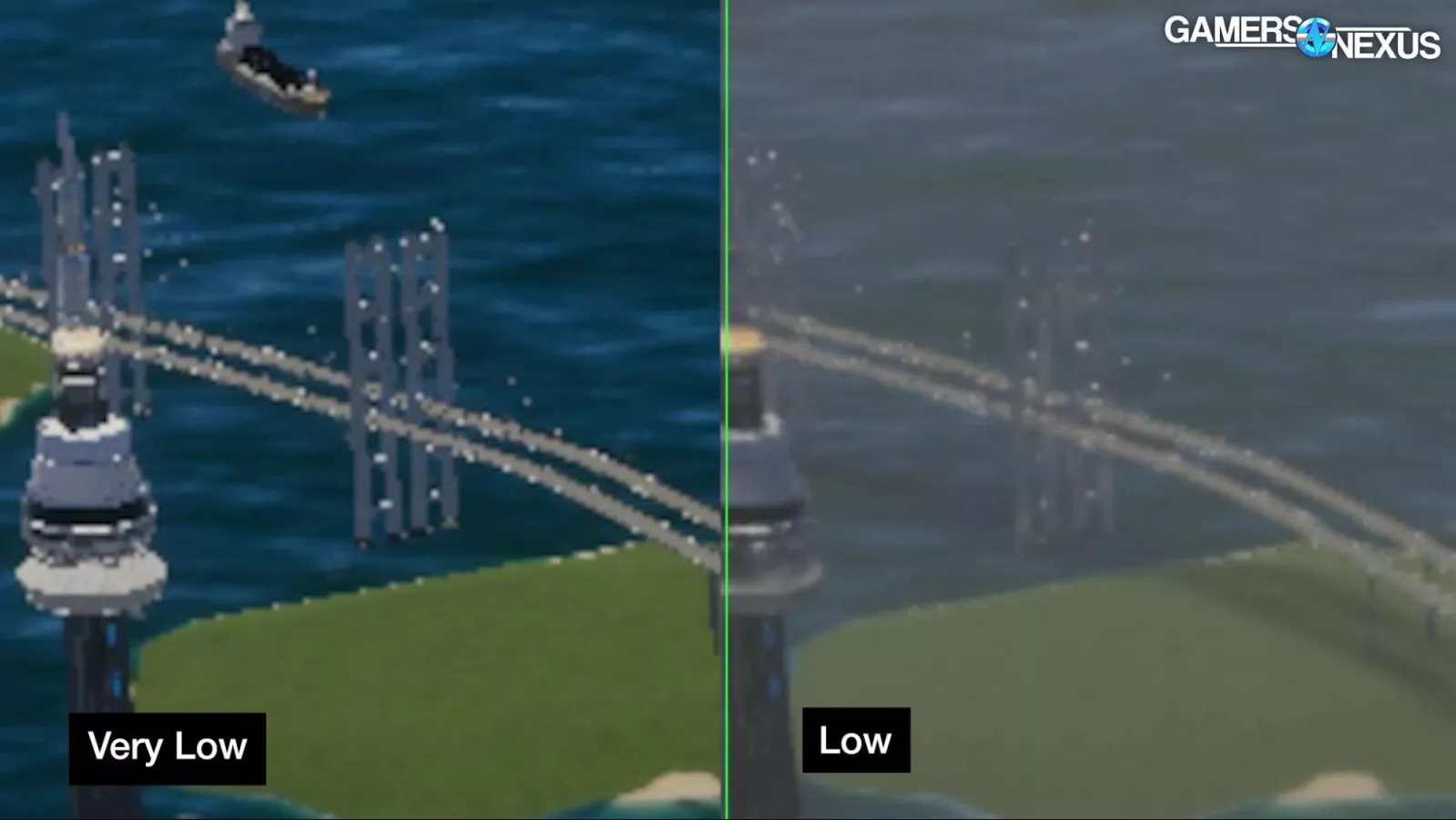
There are definite changes related to anti-aliasing between the presets, but not always in the expected direction. Moving from zero AA to FXAA by bumping the preset from very low to low dims some of the sparks along the edges of roads and bridge wires, but the fog is also a factor. The shimmering actually increases on the sides of high-rise buildings in combination with increased LOD, and becomes even more prominent at the medium and high presets. As we zoom closer, the buildings become almost grainy with detail at those higher presets.
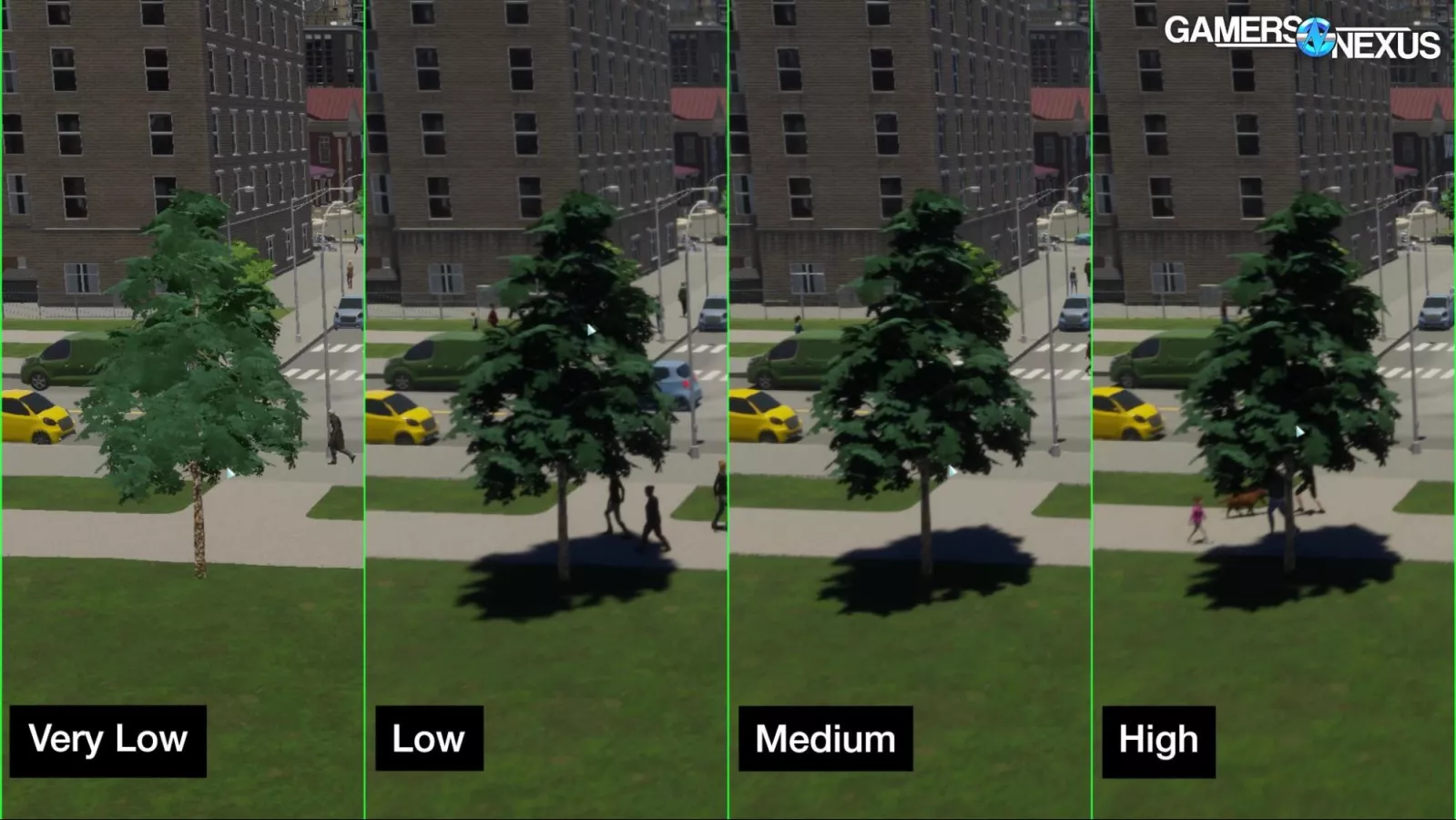
Zooming into a single street, we can begin to see more subtle differences between the presets. The shadow under this tree next to the sidewalk is slightly sharper at the medium and high presets than it is at low.
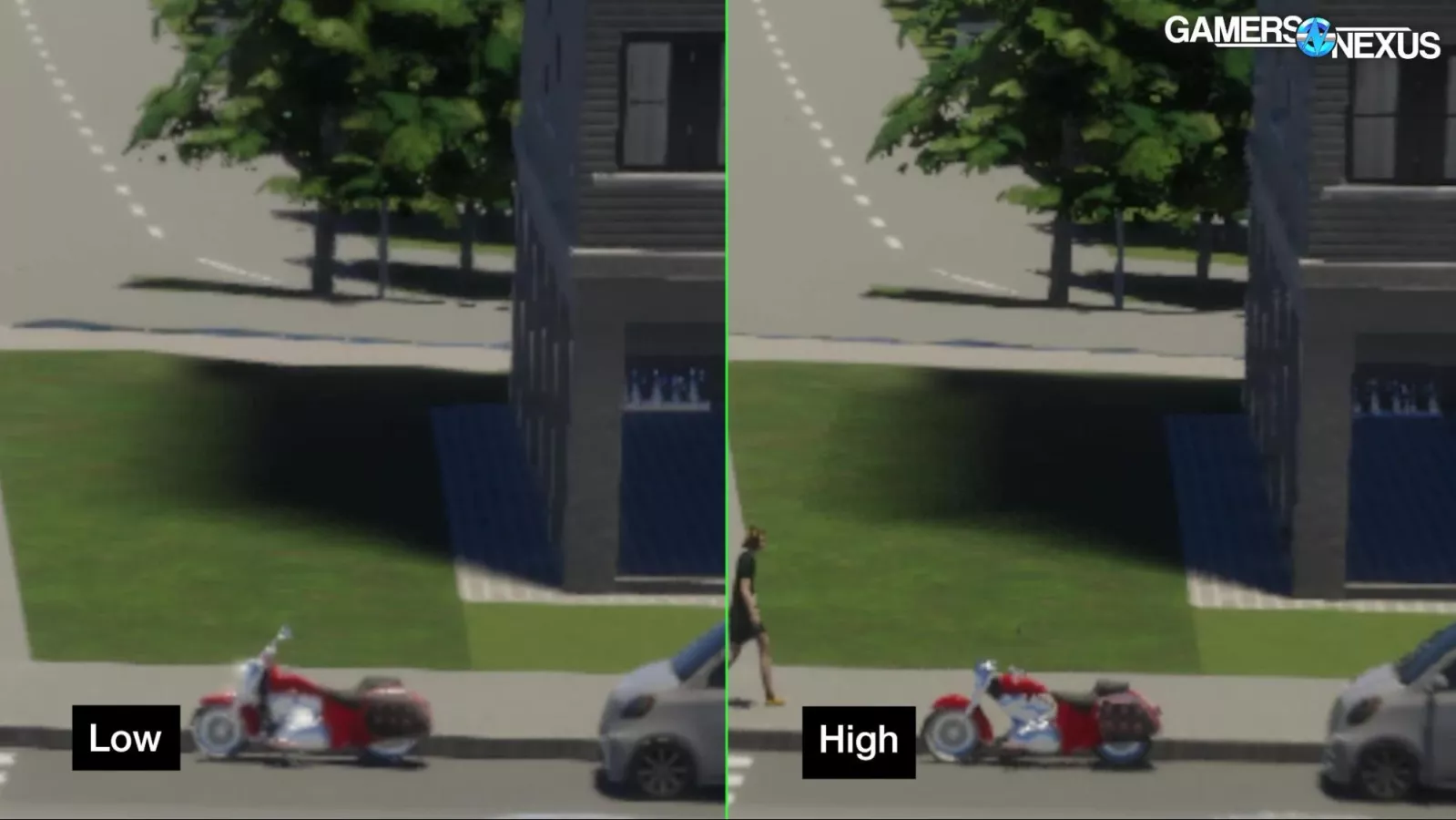
In addition, the dithered edge of the shadow of the brick building at the right of the above image becomes sharper as well.
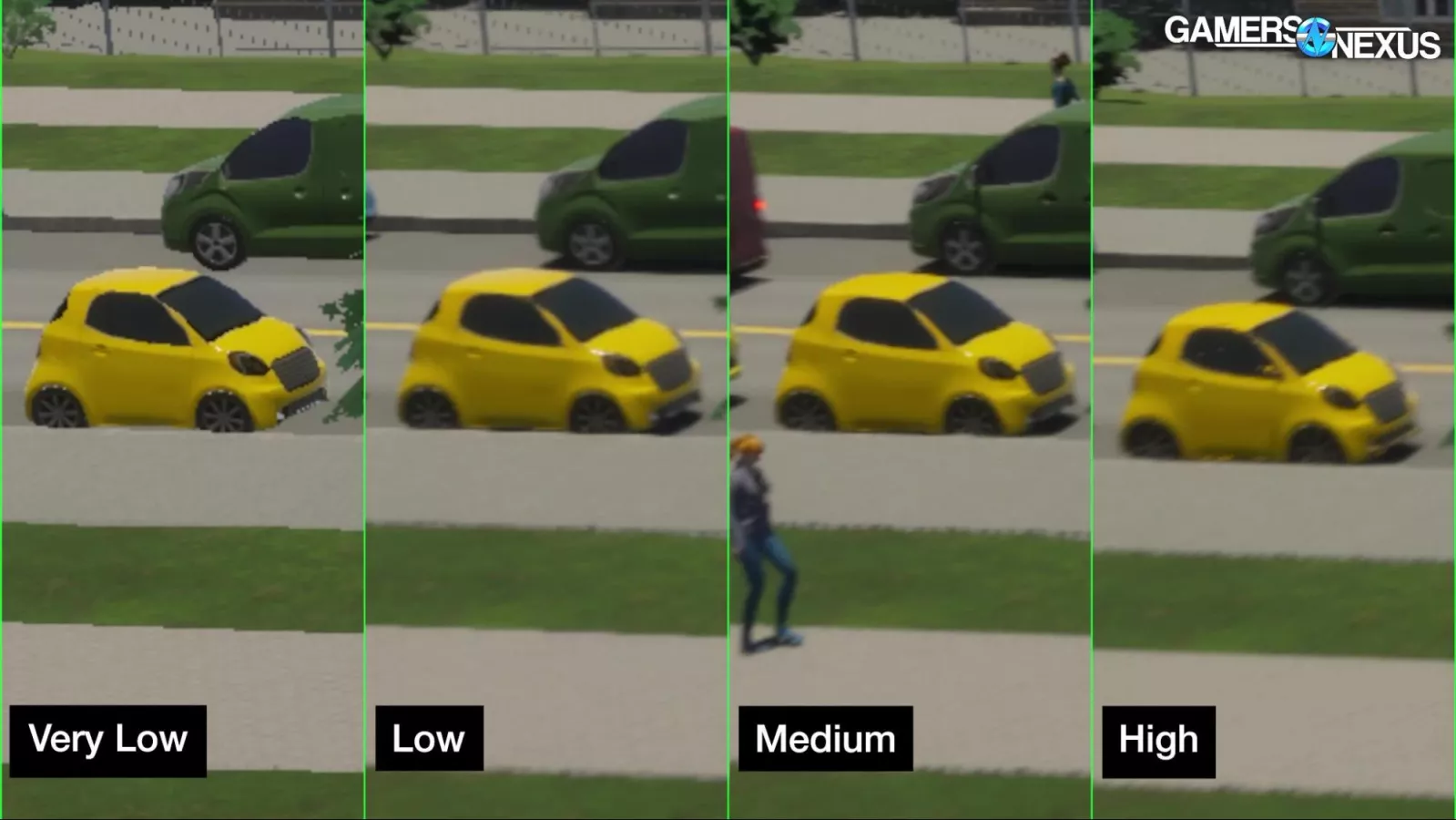
Specifically at high, the small yellow car parked along the street here casts shadows down from their side mirrors, but that's because the LOD setting erases their side mirrors at this distance.
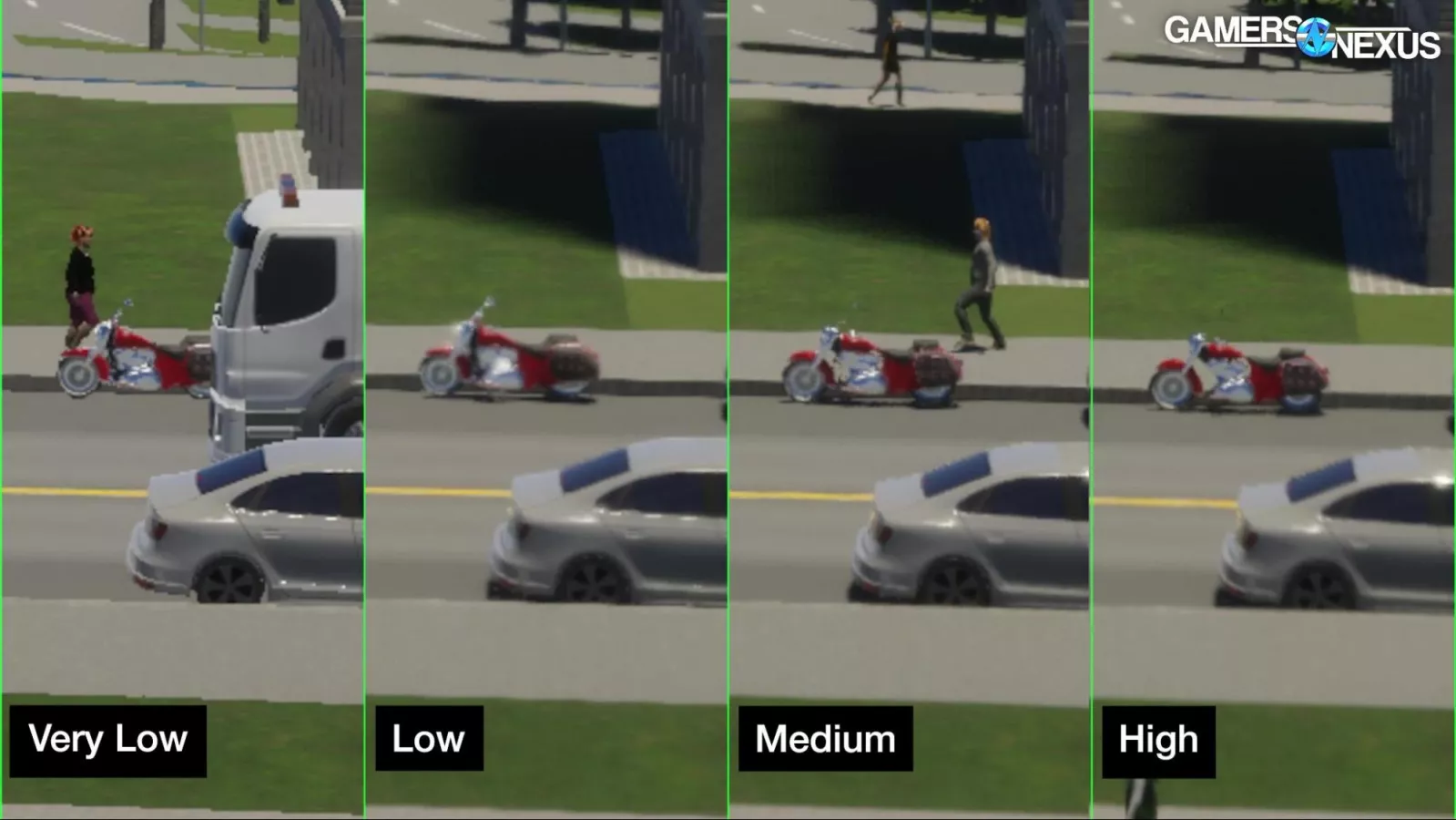
Also, the handlebars on the red motorcycle below are completely erased (likely by AA) at the two highest presets.
Zooming along streets, motion blur is nonexistent with the very low preset, but increases in intensity from low to high. In addition to the intentional scaling of blur quality, lower FPS at higher presets is a potential factor here: the developer specifically warns that "Motion blur can be very visually disruptive if you have low FPS."
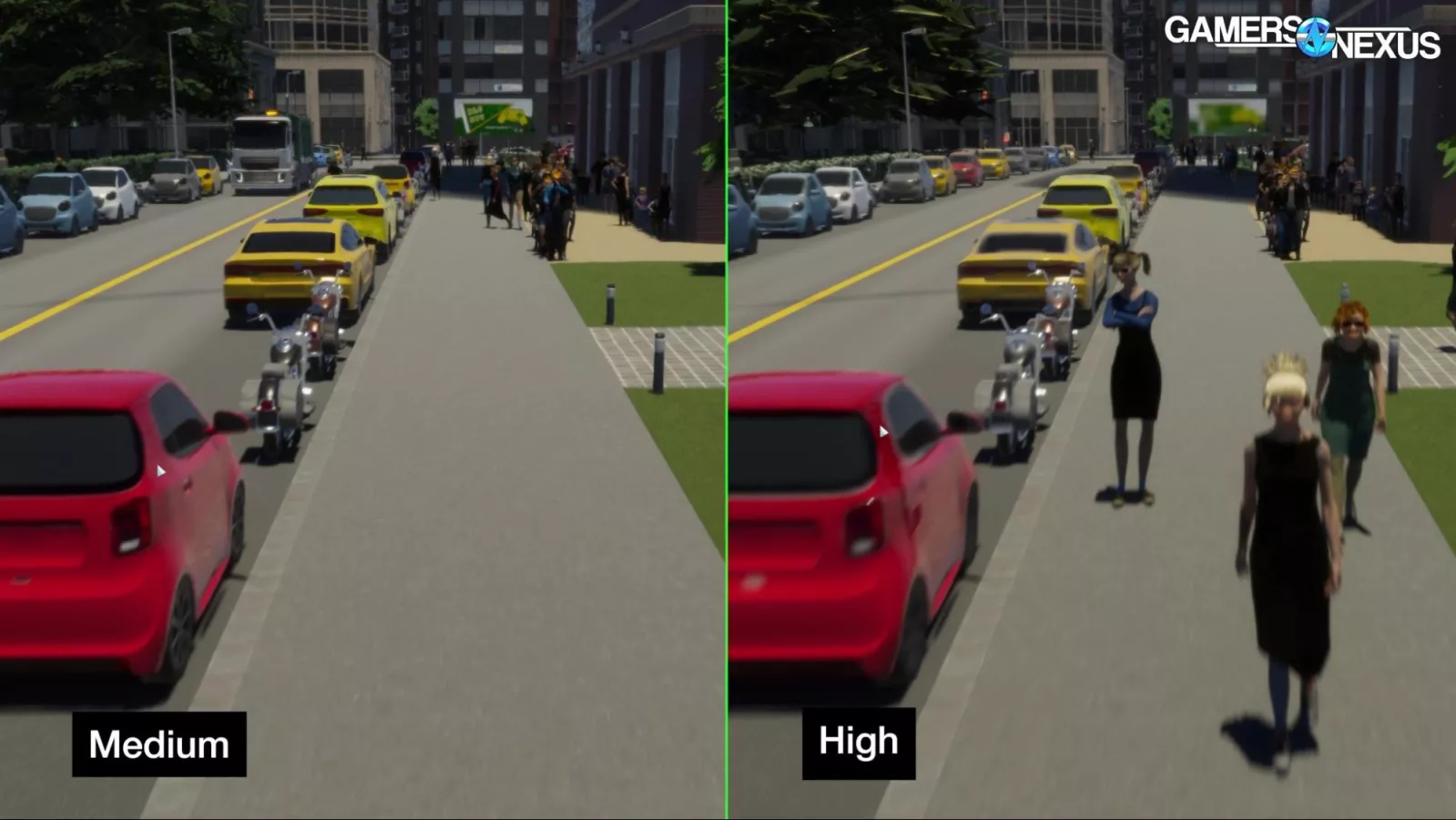
Moving to the very end of our course, scaling in reflection quality is visible in the cars lining the street. At medium and high, the cars lining the street clearly reflect their own side mirrors, while progressively more detail is added to the reflections on the side of this red car.

Bizarrely, the quality of the textures on the signs at the end of the street get progressively worse with each step up in preset quality. At very low, the green-and-yellow billboard is crisp and readable, but at high, it's no longer recognizable as a billboard at all. Other nearby textures suffer the same effect, like the benches and the leaves on the trees. We also saw this in the street textures when up close, the back of cars, and other objects. This seems either completely broken -- as in, they flipped the settings -- or seems to be an issue with rendering due to load intensity elsewhere. This was captured on an RTX 4090, so VRAM is not a limiting factor.
Overall, isolating our analysis to this specific benchmark course, we don't see any compelling reason to pick a preset above medium. Other than some reflections, even low doesn't look much worse than high in this area. Again, we disabled resolution scaling for these comparisons, so we're not taking that into account. It uses an FSR 1.0 implementation, so you get a lot of flickering and polka-dot patterns as they pop in and out.
Conclusion

First off, we need to address something that we saw in a few reddit posts online: Some people were claiming that disabling depth of field boosted them from 22 FPS to 122 FPS. We saw a Steam review that also claimed multiples of uplift.
That isn’t true. That’s not happening. Depth of field will not provide that much uplift. We noticed that Skylines has issues with applying resolution and we had a few bugs where it’d shift to a higher resolution than initially specified. We think the more likely scenario is that someone reset the resolution without realizing it. Something else is changing, because we could not replicate those numbers in any scenario.
As for performance impact: There’s a huge swing from very low to low. The developers have bad defaults here -- they should have more even spacing, or add another named setting between these, to give players a better balance without making the game look like trash. An example might be "Ultra Low" to drop-in below very low, then low above that. That'd give them some room to close that 2x gap between very low and low, allowing players to balance visuals better with the performance cost.
Older cards have the most trouble here, but to get some performance out of them, try bumping shadows down and tuning volumetric effects. Check the settings guide section for more advice on which options to tweak.
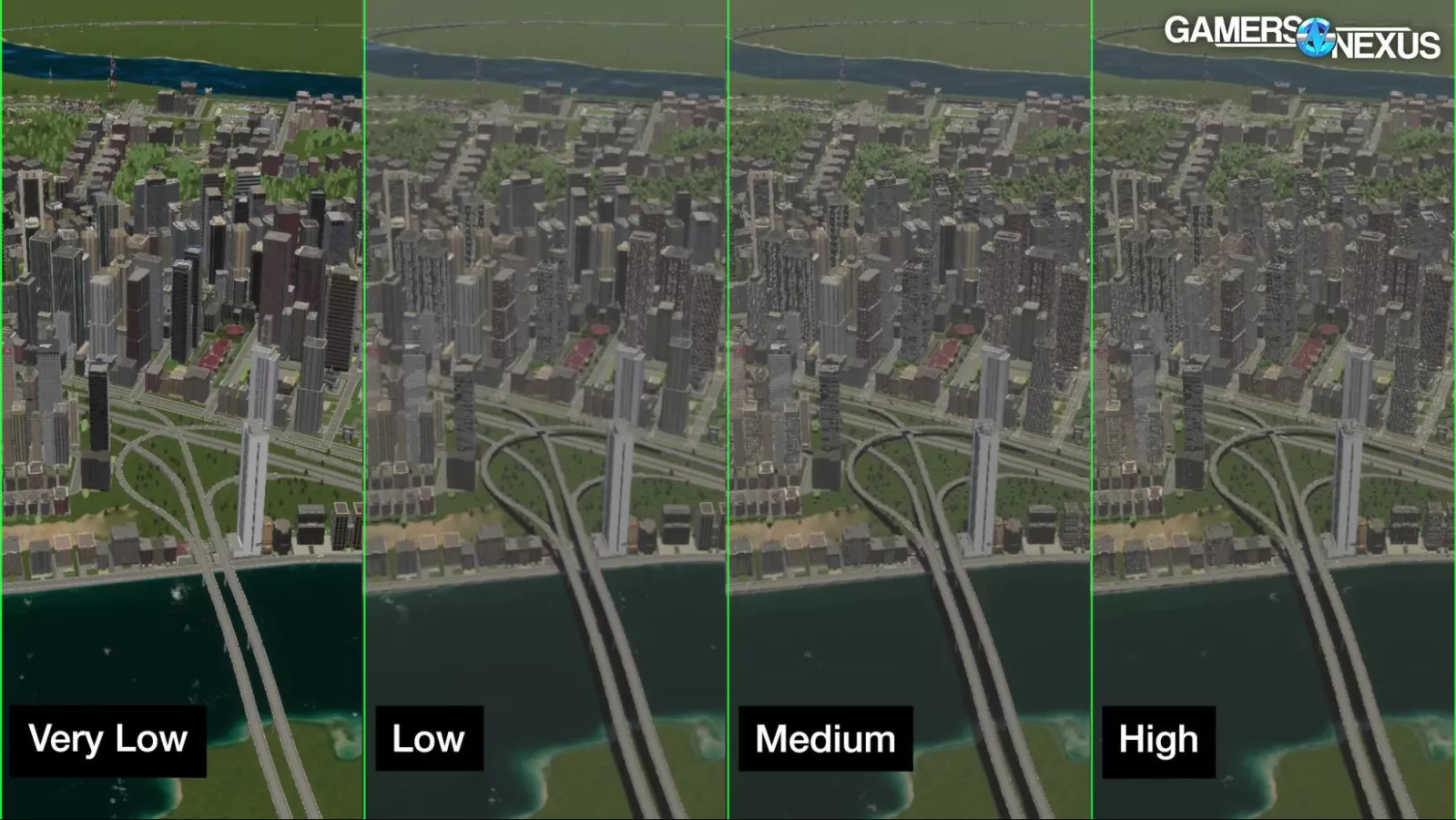
Best GPU for Cities: Skylines 2
If it wasn't already made clear, Cities: Skylines 2 is currently a mess, but if you’re keen to play it right now, we’ll give you our GPU recommendations across two framerate targets (30FPS and 60FPS). 60FPS is obviously preferable for most of our audience, but considering how poorly optimized the game is, that target may prove a bit too financially costly to some. In addition, seeing as how Cities: Skyline 2 isn’t some fast-paced shooter that requires pin-point precision accuracy, 30FPS becomes a more tolerable framerate here.
Speaking of target, we’re going to base our recommendations on 1080p/low and 1080p/medium. While the very low setting does show a big uplift in performance, the resulting visual downgrade isn’t worth it in our opinion. Furthermore, the visual uplift from medium to high isn't significant enough to justify its bump in performance cost.
The two GPUs that make it over the 30FPS average hump at low include the GTX 1080 Ti and the RTX 2070, which got 32 and 31.7, respectively. Owners of these cards skate by. If you’re looking for something newer to purchase, the RTX 4060 and RX 7600 would be our picks. They got 34.4 and 37.4 average FPS, respectively. The AMD RX 7600 offers a better value at $260 since it’s cheaper by roughly $35, but the 4060 can hold its own in other games -- ones not named Cities: Skyline 2. Broadly speaking, the RX 7600 provides a better value here.
If 60FPS is what you seek, we recommend the RX 6800 XT. AMD’s GPU garnered 63.7 average FPS. In terms of current street price, it'll run you about $480. It's technically last gen, but it's often better than the 7800 XT.
Both the RX 6800 XT and RTX 3080 (and likewise, the modern 4070) are also respectable cards that can handle the game at 1080p medium, garnering 45.4 and 39.9 average FPS, respectively. The RX 7700 XT is a more affordable option here. It garnered 39.2 average FPS. That card carries a street price of $440. If you're aiming to game at 60FPS on medium, we would recommend stepping up to the RX 7900 XT. Our PowerColor Hellhound variant garnered 60.2 average FPS. It currently retails for $800.
